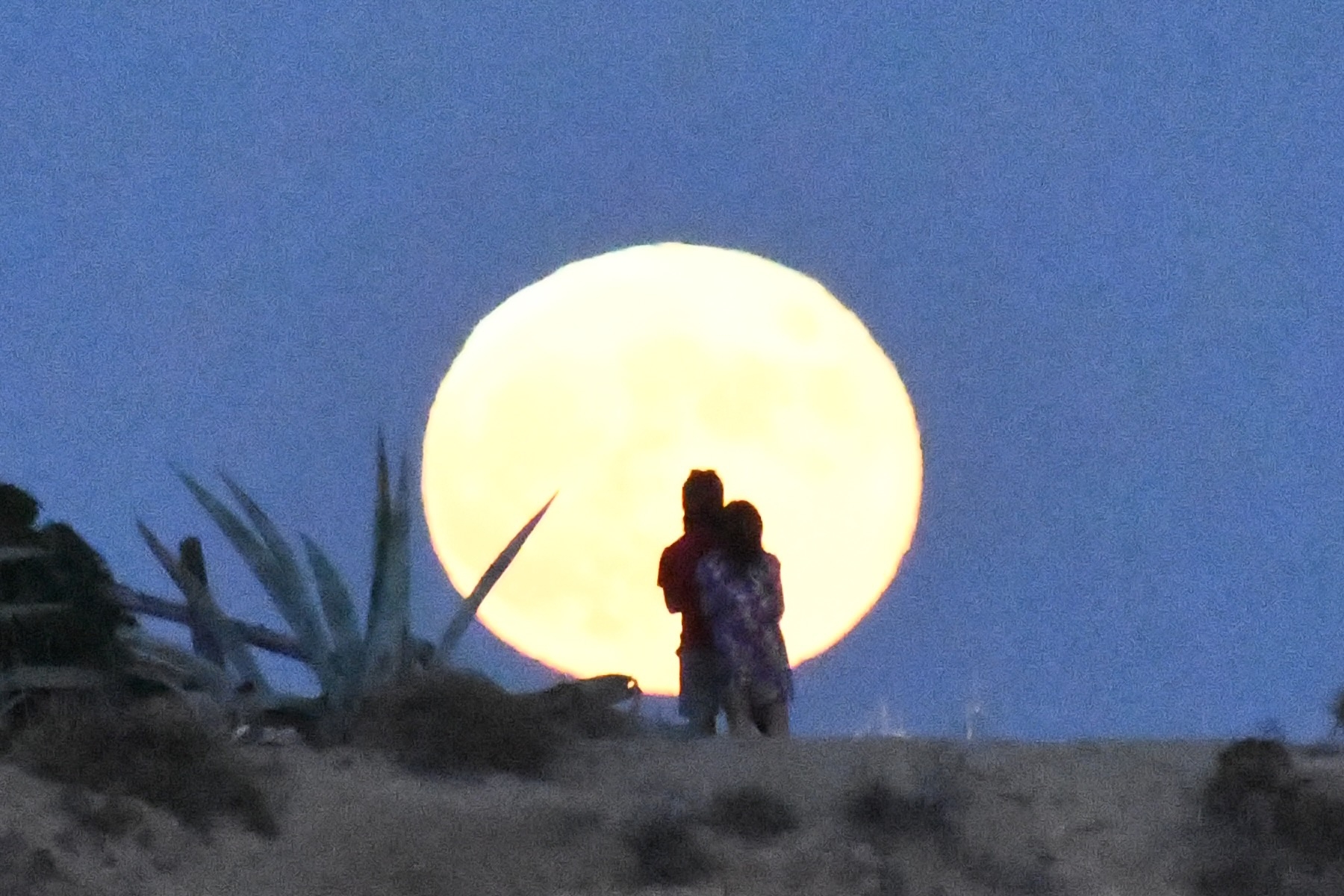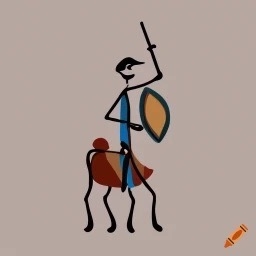A stream-of-consciousness regurgitation of a trip to the Iberian Peninsula in the “Book a Trip” Series.
“Well, I’ve Never Been to Spain, yeah
But I kinda like the music,
They say the ladies are insane there,
And they sure know how to use it…”
Three Dog Night – Never Been To Spain”
I’ve been to Spain twice but couldn’t stop the “ohrwurm” (a German word literally translating to earworm), despite its lack of relevance, from playing the song in my head or sharing it with those around me. You have to appreciate the contradiction of singing the song while you are in Spain. It’s an interesting thought that the song was playing in my head because we weren’t listening to music, filling a music void like the missing frequencies hissing in my tinnitic ears. Without an externally given purpose, does my head also fill in intentional voids, a kind of existential “omwurm”? Does the brain abhor a vacuum?
I visited Spain and Portugal with family back in the early 80’s. I remember the names of the places we visited because I liked to read maps to know where I was going. Besides the names, I barely remember anything about the sites we visited, aside from an unforgettable trip to Tunis that involved seasickness, pure panic, and a hotel towel turban (I have yet to write this piece, but when I do, you will find the link here,) —and watching a bullfight, which I thought was more of a bull slaughter than a fight no matter how close the matador let the bull get to him. There are two reasons why I remember so little about the destinations apart from the intervening forty years. First, we traveled by tour bus, so much of the experience was sitting on an air-conditioned bus doing whatever we used to do to occupy our brains in the days before cell phones, not having to make any decisions or navigation.
Second, I had no connection to the places. Malaga, Seville, Granada, Lisbon, and Madrid were just names on a map. I want to say I visited Toledo, too, because I have recollections of the bus driving through a gate in a stone wall surrounding a city, and I can’t think of any other place that might be. Without a story, one cathedral or castle is as good as the following, and droning tour guides seldom provide more than dry, disjointed facts. There is nothing wrong with adventure for adventure’s sake except the missed opportunity to appreciate what you see.
So, to give my latest trip more context, I chose two books: an audible book, “The Alchemist,” and a print book called “In Diamond Square.” I was looking for something to give me a window into what living in that region was like. I prefer a story for its intimacy rather than some overarching historical dissertation of events.
Although “The Alchemist” was initially set in the sheep-farming hills of Andalusia, it was a hero’s journey fantasy book of a boy following his literal dream to find treasure near the pyramids of Egypt. It reads like a self-help book as the boy pursues his “personal legend” on a voyage across the Sahara, offering nuggets of wisdom like, “Tell your heart that the fear of suffering is worse than the suffering itself. And that no heart has ever suffered when it goes in search of its dreams, because every second of the search is a second’s encounter with God and with eternity.” In defense of non-allegorical self-help books, most of us don’t have supernatural powers. You might need more than self-help if you start talking to the winds and the sand, and they answer back.
According to the boy’s mentors, “… when you want something, all the universe conspires in helping you to achieve it.” The ostensible reason for our Portugal destination was something my friend wanted. He wanted to evaluate the Algarve region as a retirement option. I have yet to succumb to retirement planning. So, this journey wasn’t about my “personal legend” but in support of a “personal legend.” I tried to play my role as a part of the conspiring universe to help achieve this dream, but it was DOA. My friend was already thinking of other, closer places by the time we undertook the journey. But, “When someone makes a decision, he is really diving into a strong current that will carry him to places he has never dreamed of when he first made the decision.” Despite the premature conclusion of all personal legends, the currents of the original decision were still strong enough for us to proceed with the trip anyway.
“In Diamond Square” was somewhat more relevant, set in Barcelona before and after the Spanish Civil War. We visited Placa del Diamant in Barcelona, sitting down for a Damm beer, learning that the only free about the Free Damm was its freedom from alcohol. The square wasn’t much to see: two lime-green city workers hosing down a fenced-in playground with high-powered water guns, a family overseeing the courtyard from their balcony, the graffiti-tagged roll-up steel doors that front most stores, men unloading grain from a truck, a woman disappearing into a door within a door apartment entrance, a few trees, the park benches haphazardly arranged to face the center of the courtyard, and a mother breastfeeding a kid who was old enough to ask.
In the corner near the patio restaurant is a statue of Natalie, the protagonist of “In Diamond Square,” trapped with her pigeons in the sheet metal matrix with an expression that reminds me of “The Scream.” I’ve never evaluated a statue on its ability to capture the essence of a book, but I thought this effort represented. You be the judge.
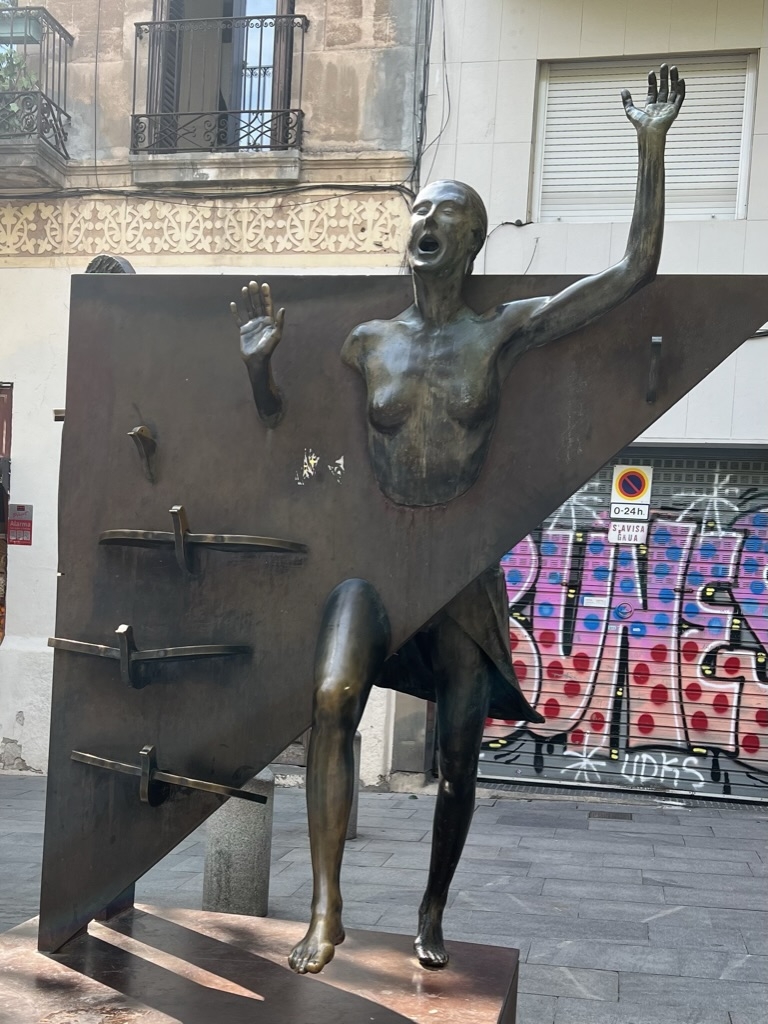
Compare the figure to the passage:
“…I put my arms over my face to save me from whatever was about to happen and let out a scream from hell. A scream I must have been carrying deep inside me for years and a little something else ran from my mouth alongside that scream that was so vast it was hard to get out of my throat, like a cockroach made from saliva, and that little something else that had been shut up inside me for so long was my youth that now rushed out screaming something or another…that I’d been forsaken?”

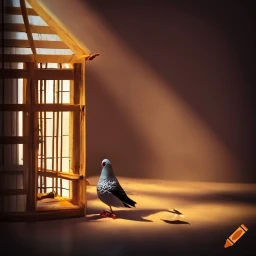
The imagery of “In Diamond Square” puts you in even the most mundane scenes. One passage is the best description of drizzle I’ve ever read: “Drops of rain played chase on the washing lines and, sometimes, one dripped down and, before it fell, it stretched and stretched because it seemed a huge effort to let go. It had been raining for a week, drizzle, not too heavy or too light, and the low clouds were so full of drizzle they dragged their swollen bellies along the roofs. We watched it rain.” I’d like to see more sculptures trying to capture Merce’s graphic descriptions: the 45-foot-long tapeworm popping its head out of Joe’s mouth that somebody must pull from Joe’s body without leaving any segments to regenerate; the unborn rat fetuses extruding from its mother sliced in half by a trap; or the dove filth that she finds herself imprisoned in.

Her imagery is as haunting as the Dark Paintings of Goya. Goya appreciation was an unexpected outcome of a checkbox visit to “Museo Nacional del Prado” in Madrid. My appreciation of art runs less than skin deep, but surprisingly, some works grabbed my attention. Goya’s Dark Paintings are both metaphorically and literally dark. The most memorable is the image of Saturn eating his son. Goya portrays Saturn as a wide-eyed, ragged, and fearful god, cannibalizing one of his sons before he can overthrow him, as is prophecized according to Greek and Roman legend, with appropriate name changes. In Greek/Roman mythology, the story ends happily when Zeus/Jupiter grows up to defeat Chronos/Saturn, forcing him to regurgitate all his brothers, happily for the brothers, anyway, assuming they are reasonably undigested. In the Dark Paintings, Goya draws his figures with black eyes accented by their contrasting white sclera in a sea of dark colors as in the “Witches Sabbath” or haunted expressions as in the “Pilgrimage to San Ysidrio.” (I looked those titles up in Wikipedia to remember.) He also did the La Maja Desnuda and La Maja Vestida, two versions of the same woman, the nude one being controversial in its day because the woman doesn’t show any shame in the display of her naked body. I might be confused because I think I only remember the clothed version of the painting, though the article says the two are displayed side-by-side. His works that appeared to be commissioned depictions of royalty were otherwise dull. The other piece that grabbed our attention was the Velázquez painting “Las Meninas.” Las Meninas means hand-maidens, though they represent only two of the eleven characters in the picture. Two are identified as dwarfs, though they look like ugly kids to me. After the visit, I googled this painting, only later discovering that there is a controversy about whether the king and queen in the mirror are watching the painter from the viewer’s viewpoint or are the reflections from the painter’s canvas.
The museum has its fair share of wall-sized medieval paintings, with seraphs and twisted necks, which I still find disturbing. (My other experience at the Louevre with medieval art, another story also not written up.) We visited a Raphael room to complete my lifelong quest to see the artwork of all four Teenage Mutant Ninja Turtles: Michelangelo, Donatello, Leonardo, and Raphael (wink emoji here). For whatever it says about me, my favorite rendering in the museum was a t-shirt with a flask of beer portrayed on it, saying, “Technically, beer is a solution.”
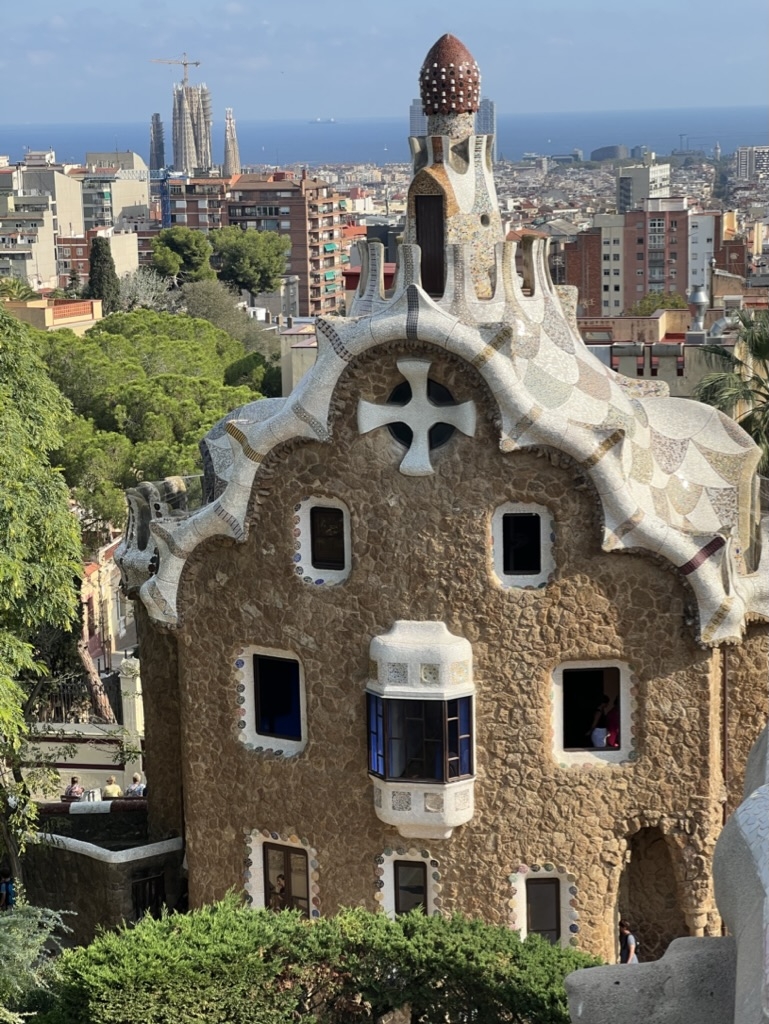
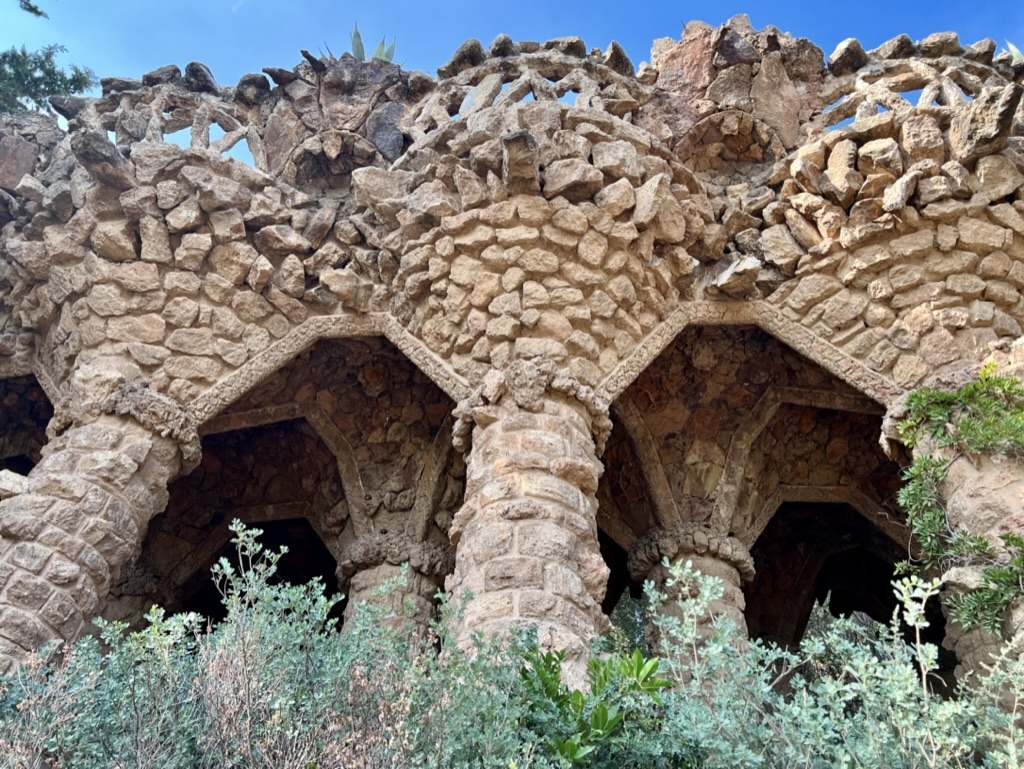
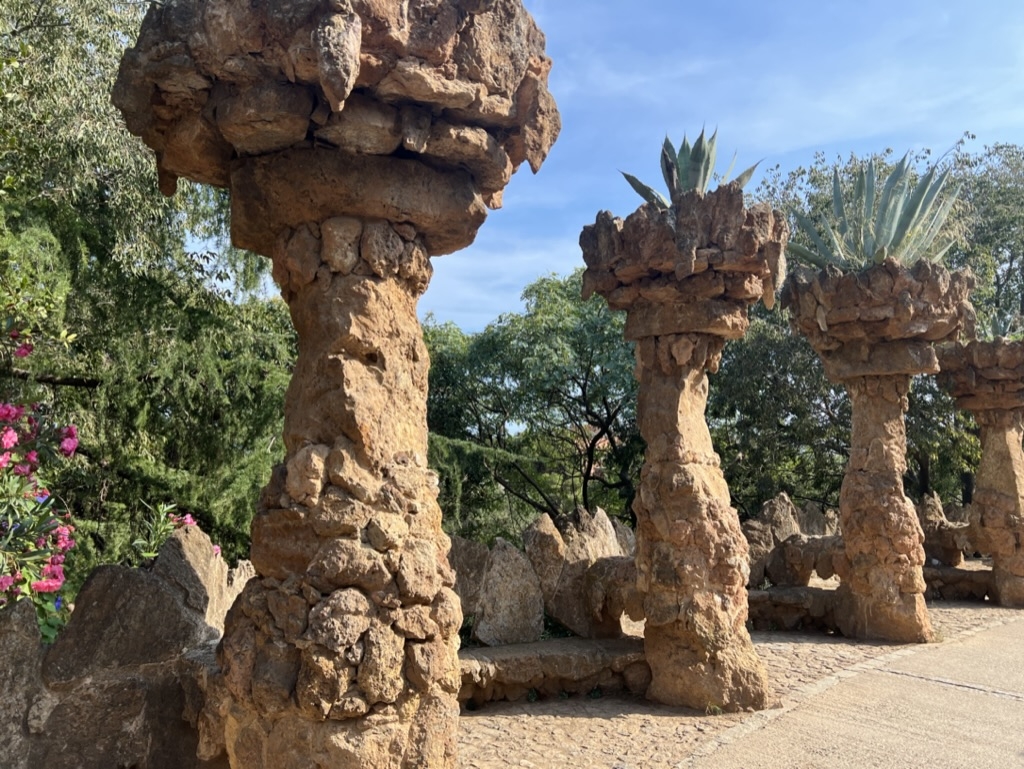
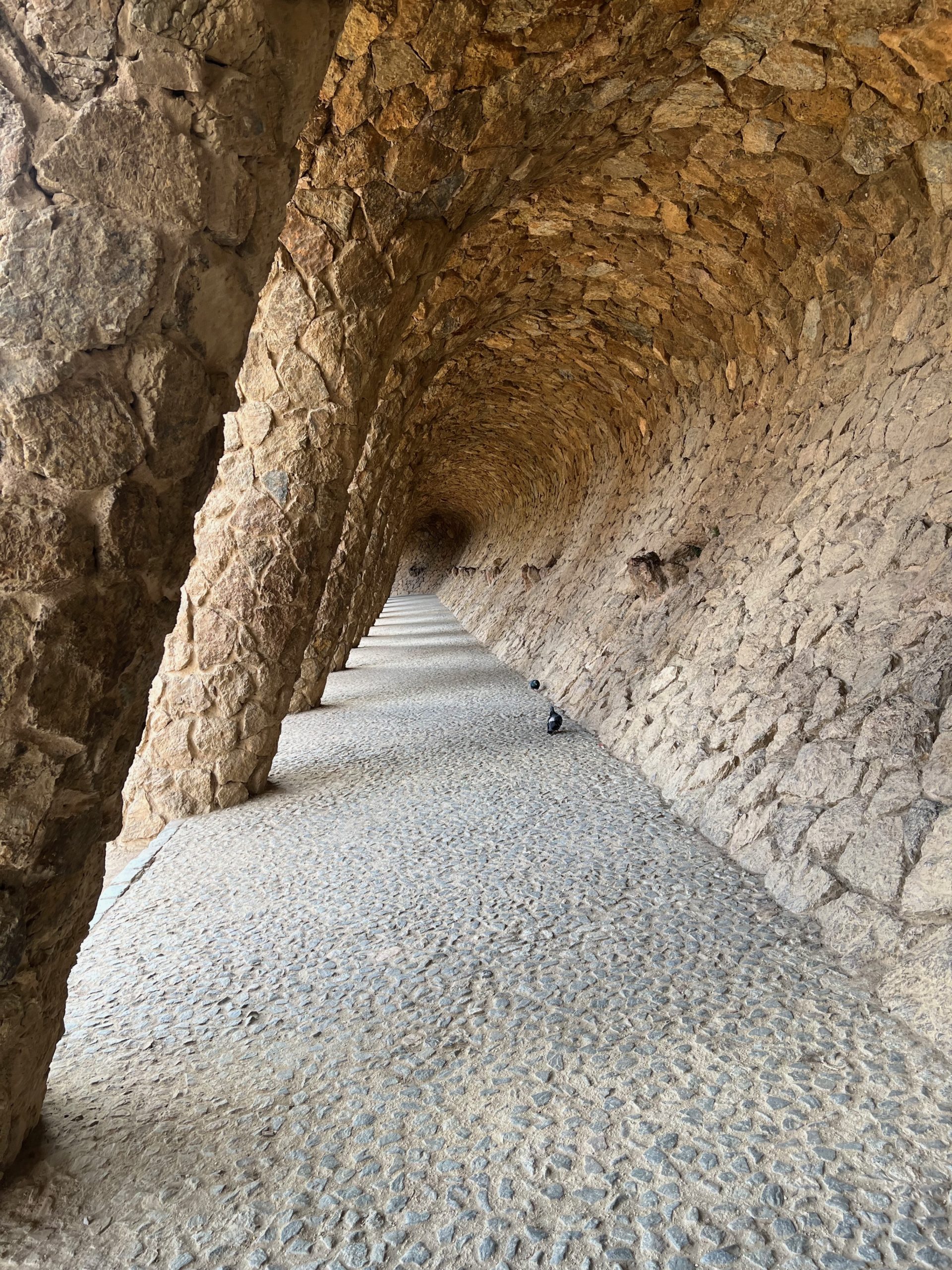
The Prado has one very out-of-place Picasso that should have been in a room alone because it seemed so out of context with the paintings surrounding it. I subsequently read that Picasso didn’t much care for Goudi, the surrealist architect from Barcelona, though Salvadore Dali did. Salvadore Dali painted the melting clocks called “The Persistence of Memory,” a painting I’ve admired several times in articles and books associated with Einstein’s general relativity. But Goudi is new to me. We visited the Park Guell in Barcelona to see Goudi’s work. I have mixed feelings about it. Walking through the irregular patterns (an oxymoron?) of leaning stone archways and flowery columns was a Seussian experience, but I didn’t care much for the gingerbread houses. I once read that surrealist paintings try to capture faces at different times on the same canvas. That characterization makes sense when looking at the multiple expressions on the same face in a Picasso painting, but I’m unsure how that plays out in surrealistic architecture. There may be something barren and ugly about the straight line. Still, I want architecture to express the pragmatic sciences of metallurgy and physics rather than the whimsicalness of surrealistic art. As impressive as the skyline-dominating Sagrada Familia cathedral is, I’m pretty sure that is not where I would run to ride out an earthquake or weather a storm.
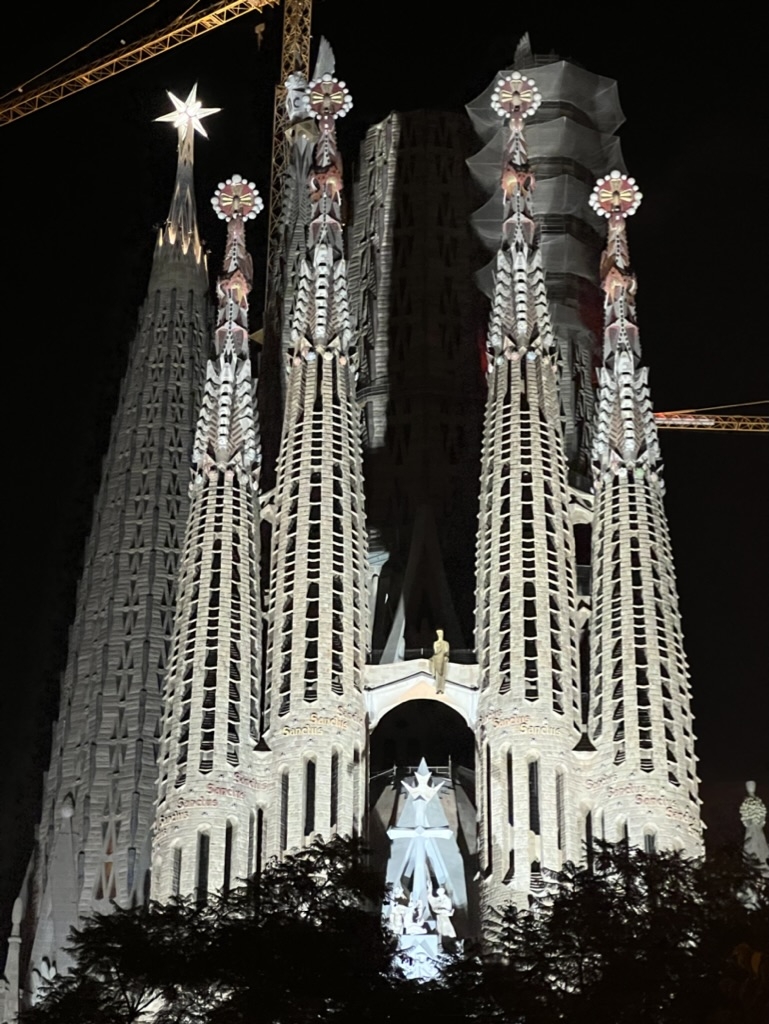
Unfortunately, we didn’t see the interior of the Sagrada Familia as we failed to book a reservation sufficiently far in advance, as we learned during lunchtime gone bad. Our guide, host, and reason for visiting Barcelona tried to take us to one of her favorite outdoor cafes on the median boulevard strip, but it was closed. We settled for the Plan B Sagrados Cafe restaurant, which served us an undercooked, runny Spanish omelet and a crunchy, undercooked green pepper dish that she disgustedly returned to the kitchen. The server committed a customer service foul by defending the oozing dish as classic. Meanwhile, as we speculated whether Sagrados translated into undercooked food, a sunburnt, pot-bellied, middle-aged man set up his open-air music venue on a park bench next to our table, trying to make a few euros with his singing. And as if channeling the inner thoughts of our distraught hostess, he started singing Elton John’s “Sorry,” pouring great emotion into a line, then pausing like a school kid reading a textbook to look at his phone for the lyrics, then pouring equally great feeling into the next line.
“It’s sad (So sad),
so sad
It’s a sad,
sad situation
And it’s gettin’ more and more absurd
It’s sad (So sad),
so sad
Why can’t we talk it over?
Oh, it seems to me
That sorry seems to be the hardest word.”
I don’t know if there is a German word for when so many things go wrong, the situation becomes so absurd that you can only laugh. But if there isn’t, there should be. I’ve submitted the request by email to Germany. On the upside, “Sorry” replaced “Never Been to Spain” as my “ohrwurm” for a short while, and I came away with the notion that we should all have a minstrel follow us around and channel our mood and thinking into song like Brave Sir Robin in Monte Python’s “The Holy Grail.” I gave our minstrel two euros, not for the quality of the singing, but for his impeccable timing and unwittingly perfect choice of song.
I wasn’t laughing at the Centauro car rental place when we first arrived in Lisbon. We lost the fight to get on the transport bus from the Lisbon airport to the rental car facility. Still, we beat the next bus by taking the thirty-minute walk instead lugging our luggage in the heat over uneven sidewalks and roads so I “didn’t have to end up hating all these people.” I lost another battle with the kiosk machine that issued numbers to queue up to see an agent at the facility. The uncooperative machine demanded a reservation number, which I didn’t have handy. Instead, I only had the confirmation number from Expedia, which the kiosk rejected out of hand. When I tried to ask an agent for help, she chastised me to wait in line like everyone else. I lost more battles to the wireless connection I needed for my laptop to try to log in to the Expedia website. Once I found that, I lost the struggle to find the reservation number. Perhaps the ultimate insult, the Expedia website refuted the existence of my reservation while, at the same time, sending me an email asking me to rate my Centauro experience. Germany never responded to my email either.
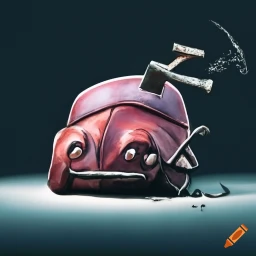
Finally, one of the agents showed me the errors of my ways. If you can’t find your reservation number, the kiosk doesn’t print a receipt, but it gives you a number you must remember to see an agent, who will then provide you another number based on the looked-up reservation. The agent tried to put the fear of God in me. Aside from the sixteen-hundred dollar deposit, he threatened me with 250 € payments for every dent as big or bigger than the size of the head of a hammer. I imagined a little person hiding in the rental car’s trunk, taking every opportunity to jump out and pound it with a hammer so Centauro could abscond with my sixteen-hundred dollar deposit. Where is my minstrel now? How about a rousing chorus from “Humans Are Such Easy Prey?”
“It can’t be bargained with. It can’t be reasoned with. It doesn’t feel pity, or remorse, or fear. And it absolutely will not stop, ever, until you are dead.”
That could be over the top, but it would have channeled my inner vibe. As a side note, I don’t think the AIs or the aliens are out to kill or torture us. They are prankish teenagers who get a kick out of driving frustrated users crazy, like giving peanut butter to a dog. But the three-hour delay wasn’t all bad. GF made friends with a retirement couple that fled to Portugal from the politics of the United States, and we learned how to identify cork trees stripped of their valuable bark, a helpful skill for the car ride to the Algarve.
Torture is the province of human-to-human interaction, as the “Museo de la Tortura” in Toledo well documents, which we visited, possibly to fill our existential void or to ponder the imponderable. Why do people torture? Is it unbridled hatred? Or sheer perversion? Or just fear and insecurity? Cue the minstrel. He should be singing the sounds of silence in the background with all the anger of Disturbed.
“Hello darkness, my old friend
I’ve come to talk with you again.”
It’s hard to imagine the line of torture thinking. Someone had to have the thought, I want to crush someone’s skull, then go out and build a device that can do it, and then actually use it on someone. The iron maiden has adjustable spikes. At some point, someone had to realize that skinny people weren’t receiving the full benefits of the spiky garment or fat people wouldn’t fit in it. So they sent it back with new requirements for a one-size-fits-all redesign. Some devices were designed for humiliation, some to extract a confession. Some instruments were designed to inspire fear in those watching the torture, but that was not always the case. The Spanish Inquisition tried to keep a low profile. I bet you weren’t expecting me to mention the Spanish Inquisition, were you? Because nobody expects the Spanish Inquisition.
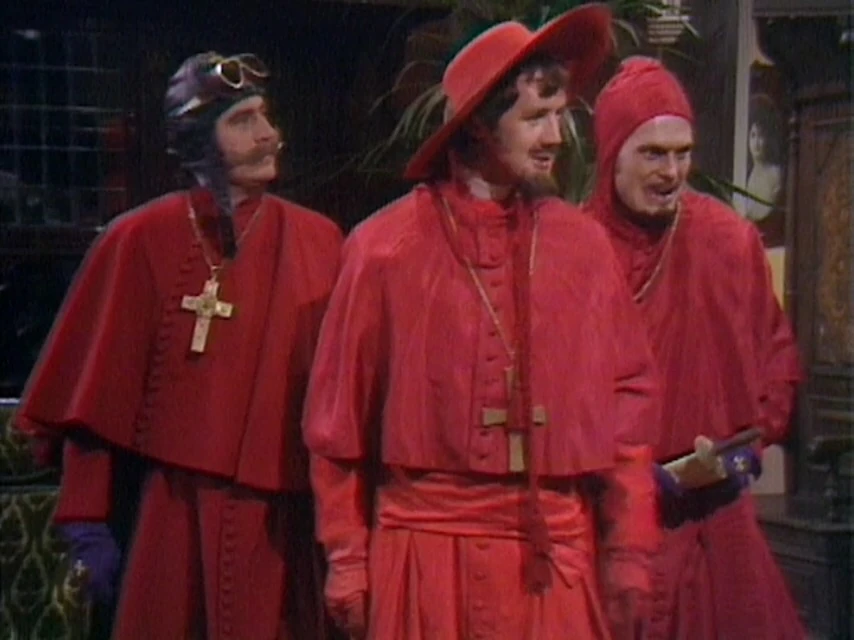
It would be easy to torture a Millenial: put them in a room without their cell phone or any access to social media. They wouldn’t have to put a pig mask over my head if they wanted to humiliate me. They could tie my hair up in a bun, loop a man purse over my shoulder, and force me into those skinny jeans that taper just above the ankles.
Torture has evolved into erotica, self-mutilation, and Mad Max movies. On the upside, I have a few new ideas for a GF birthday gift. We passed on the opportunity to visit the “Erotic Museum of Barcelona.” Yes, it exists. But sadly, I don’t have the data to further report on the topic here.
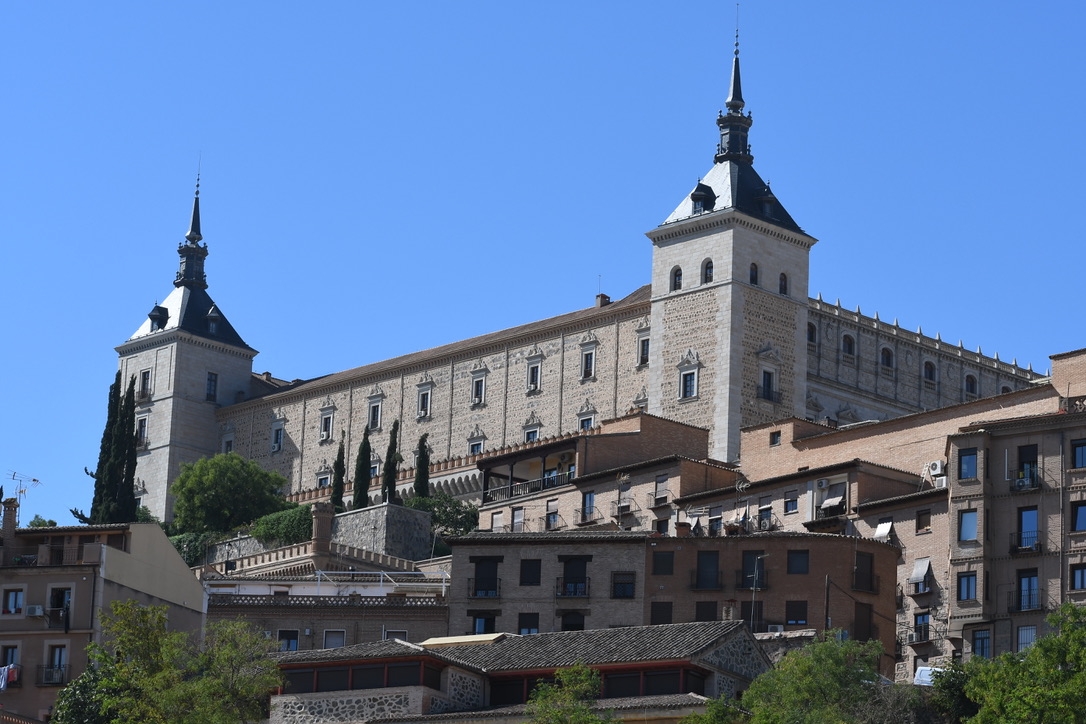
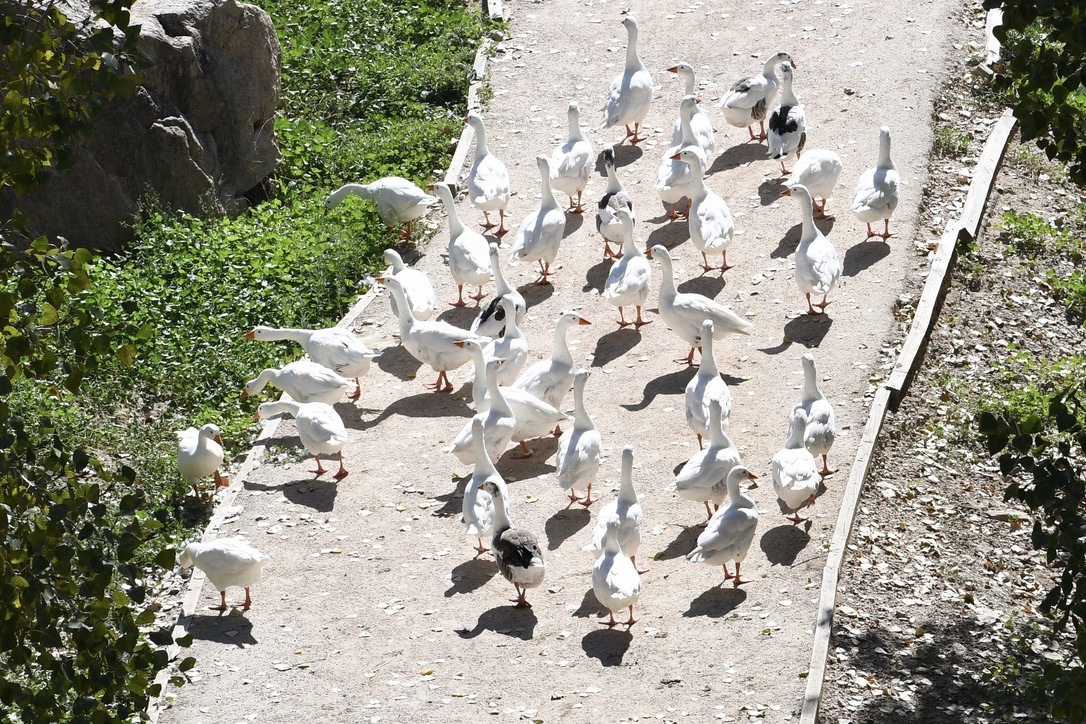
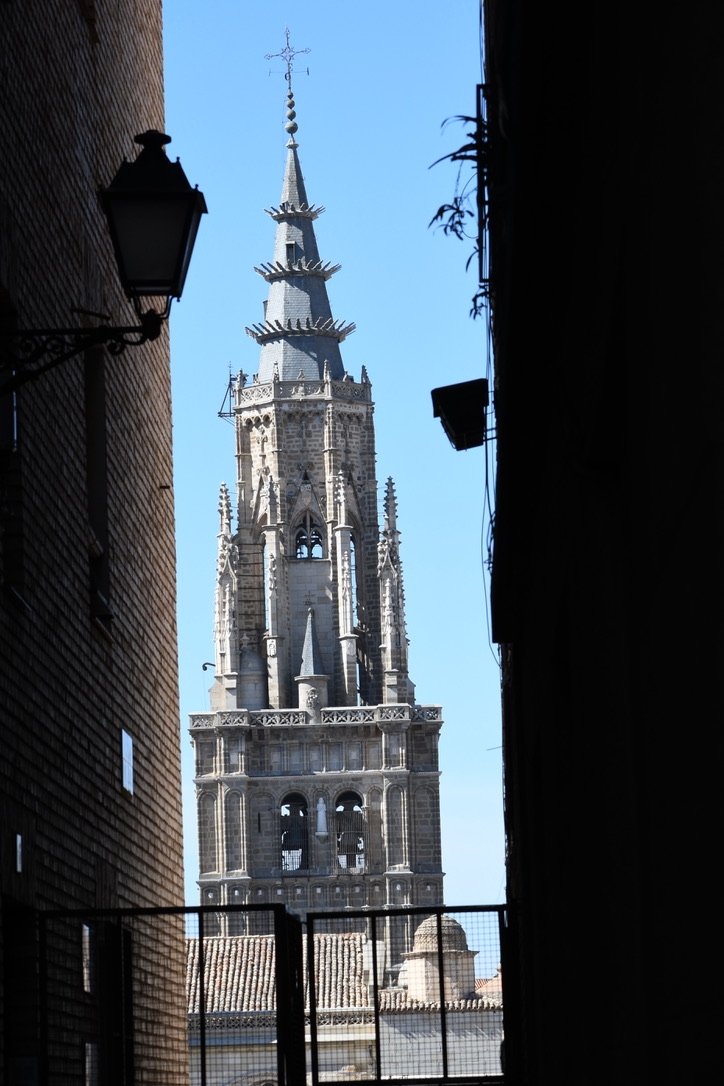
For what it says about us, given Toledo’s rich history, the torture museum was the only attraction we paid to enter. Every cultural center charges something to visit, and getting nickel and dimed to death is annoying. Or is it eurod to death? Nickel and dimes would have been easy. Our guide, hostess, and reason for visiting Madrid suggests that all the exhibits should be free so everyone has the opportunity to learn about the culture, not just those who can afford it. Amen, sister! The effect of monetization of culture warrants more profound thought. When does the culture become a caricature of itself, catering to consumerism rather than vitalism? Does a culture get to bitch about appropriation when they are selling mass marketing their heritage?
Social capital is another essay in itself. I see it as a selfie with the Grand Canyon in the background without turning around to look at it. I see it at all the stores that sell trinkets and pins to cater to the social capital of its purchasers. My hat is off to our two hostesses and guides, who have immersed themselves in the culture, learning the language, living and working in their respective cities, and finding something beyond transactional interaction. A sign of authentic travel is when the reality of isolation and uncertainty replaces the romanticism of the pre-trip, when your thought is, “What the f**k did I get myself into?” Our hostesses are doing better than I am at authentic travel, but we tried for something in between.
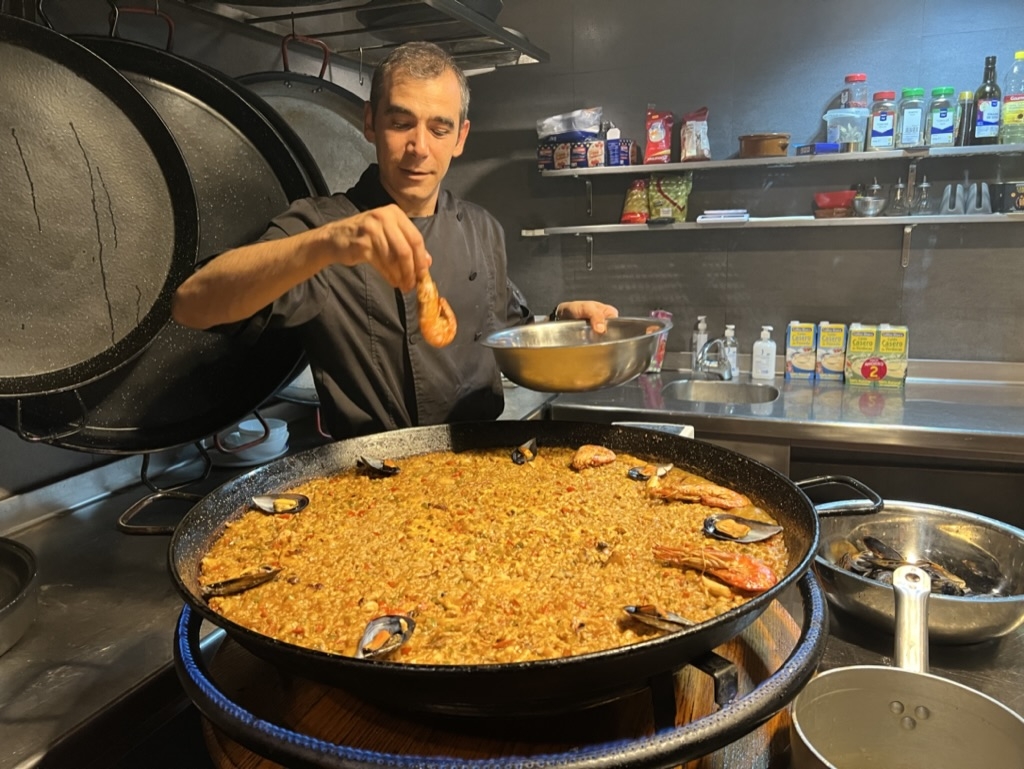
I like doing hands-on stuff, following the advice of the adage: I hear, I forget; I see, I remember; I do, I understand. In Barcelona, we attended a cooking class. We learned how to devein shrimp with a toothpick, debeard a mussel after first checking that it is alive, cut onions without crying, and put them all together to make paella in giant paella pans and burners you can buy on Amazon anywhere from 75€ to 5000€. We also socialized with other travelers over Sangria:
- A young couple of corporate lawyers from Slovakia.
- Another young couple from Germany, the boy an aspiring farmer from Korea.
- A crazy lady who solved the problem of getting me to smile for a photograph. “Smile, asshole.” (Side note: I tried it, and it also works on others.)
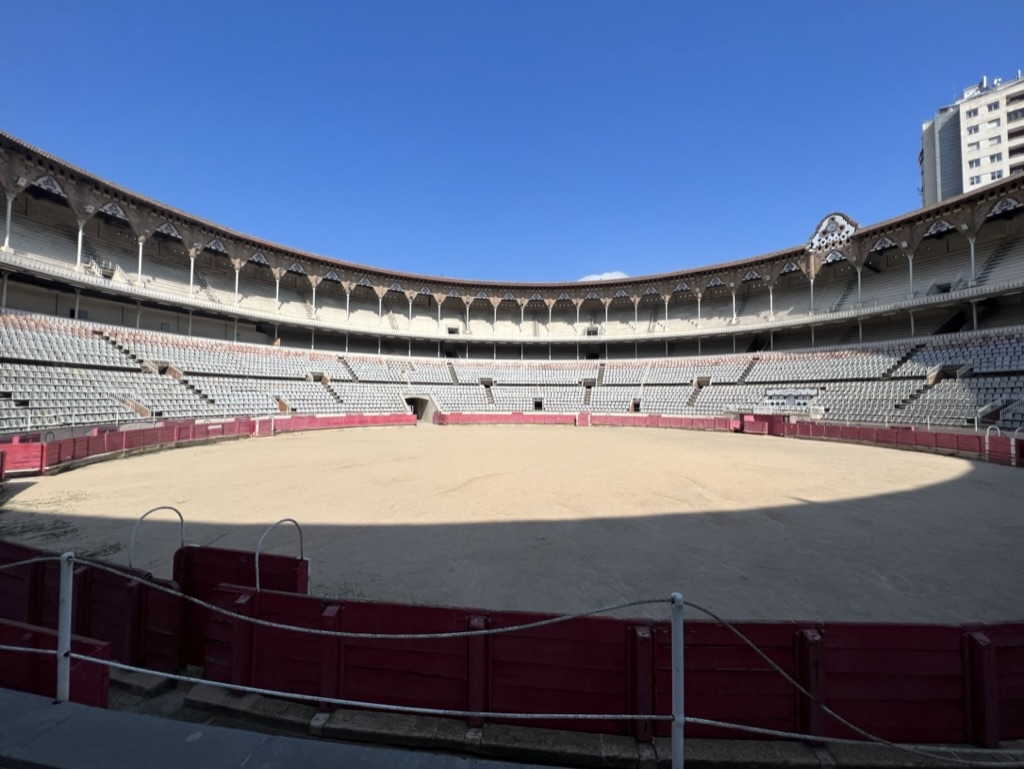
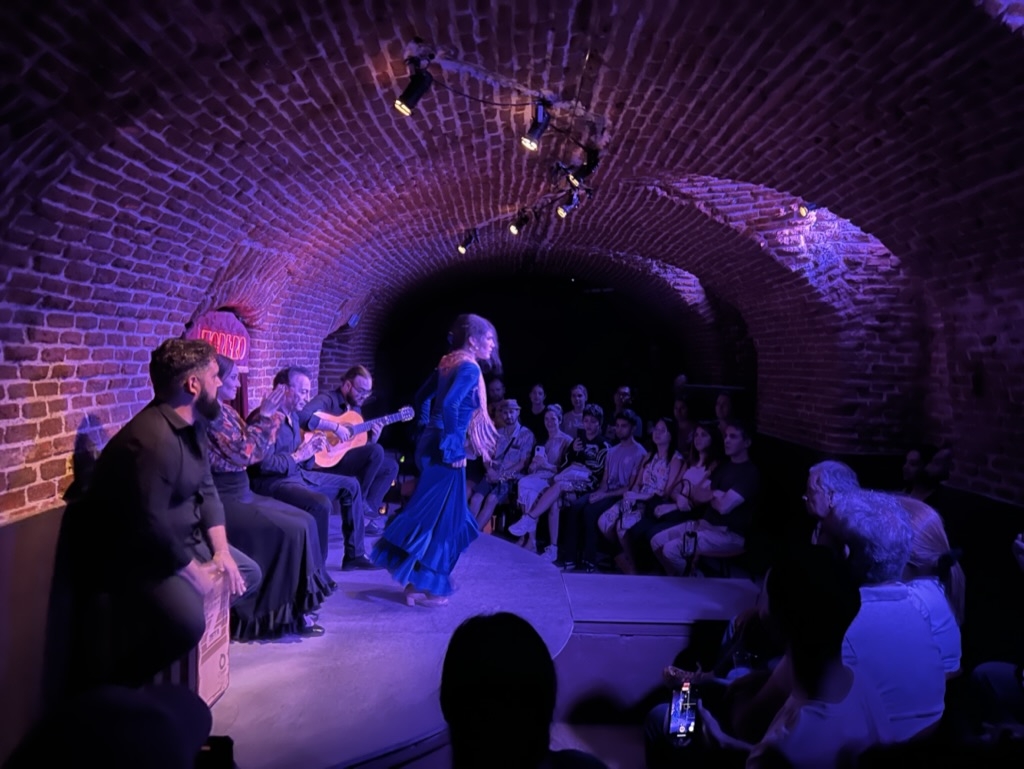
In the interest of deep appreciation, I aspired to take flamenco and bullfighting classes, but neither panned out. We settled for a Flamenco show in Madrid and a walkabout in the old Bullfighting Ring in Barcelona. Flamenco dancing was not performed by flamingos but by dancers, a cube-shaped bongo player, a guitarist, and a singer. (NOTE: The bongo is cube-shaped, not the bongo player. Technically, it is called a Cajon.) In the intimate setting of a stone-walled cellar, the intricate, pounding footwork dances its way viscerally into your body. By the way, if you’ve never seen the dance of the Flamingo, you should view it on YouTube.
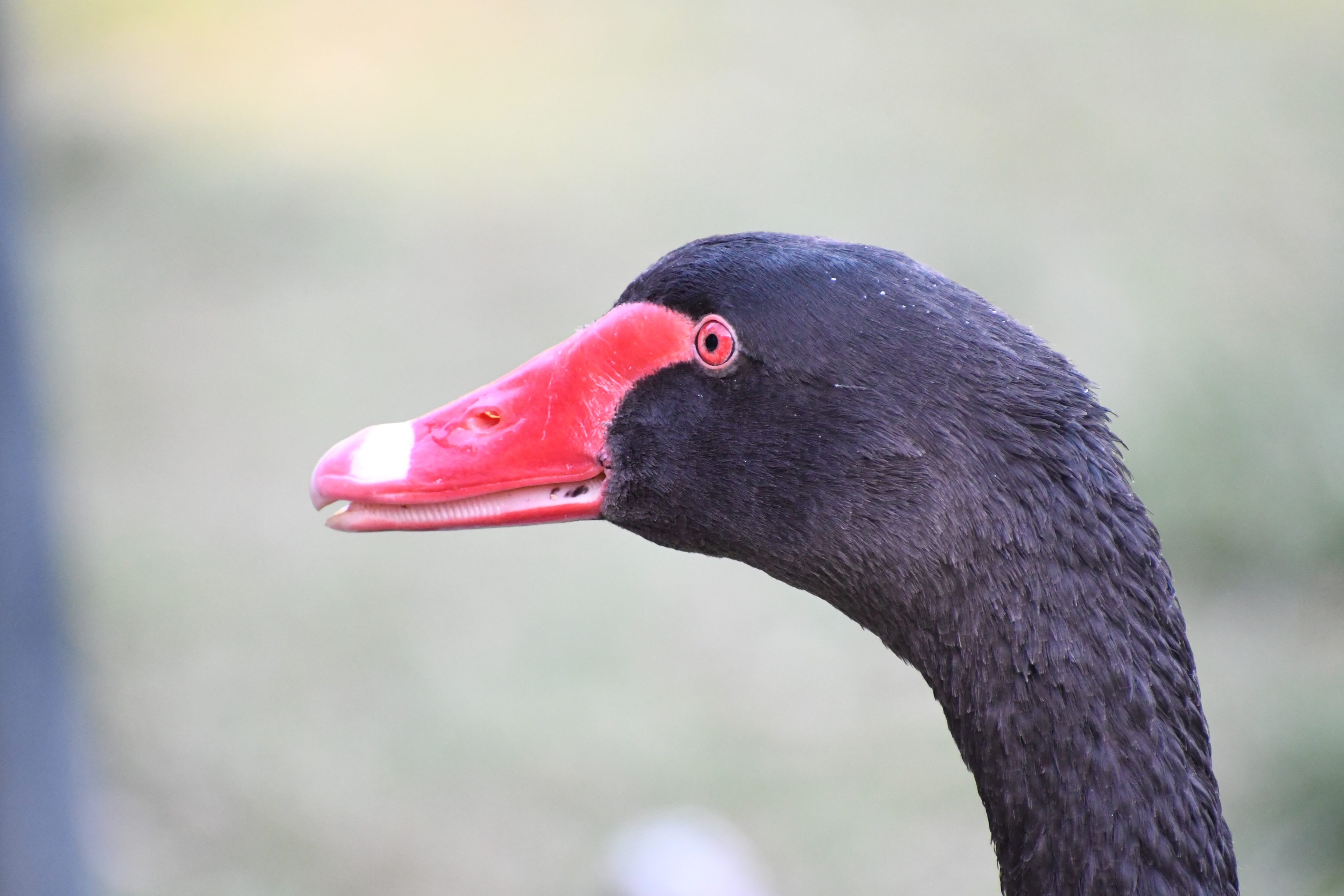
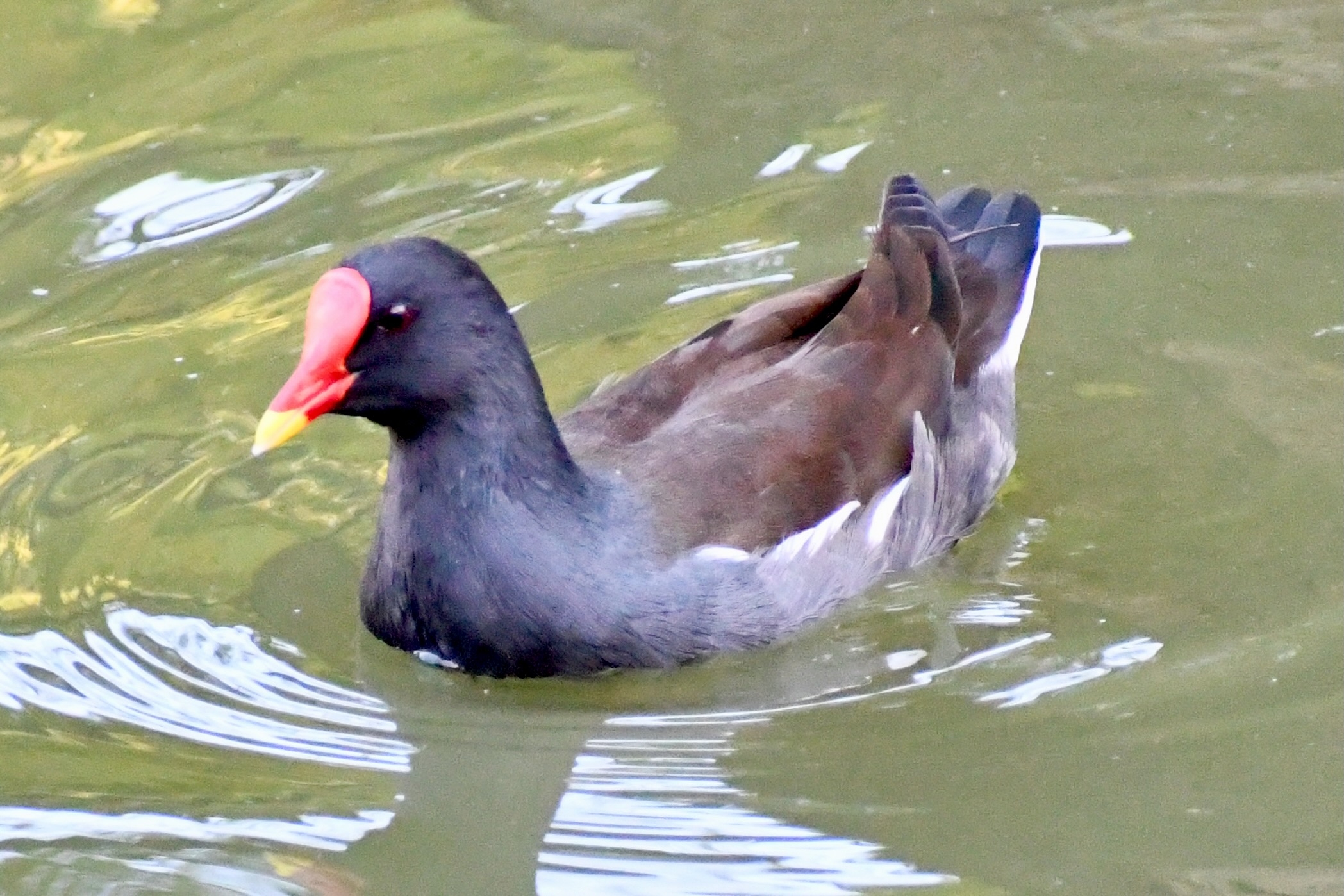
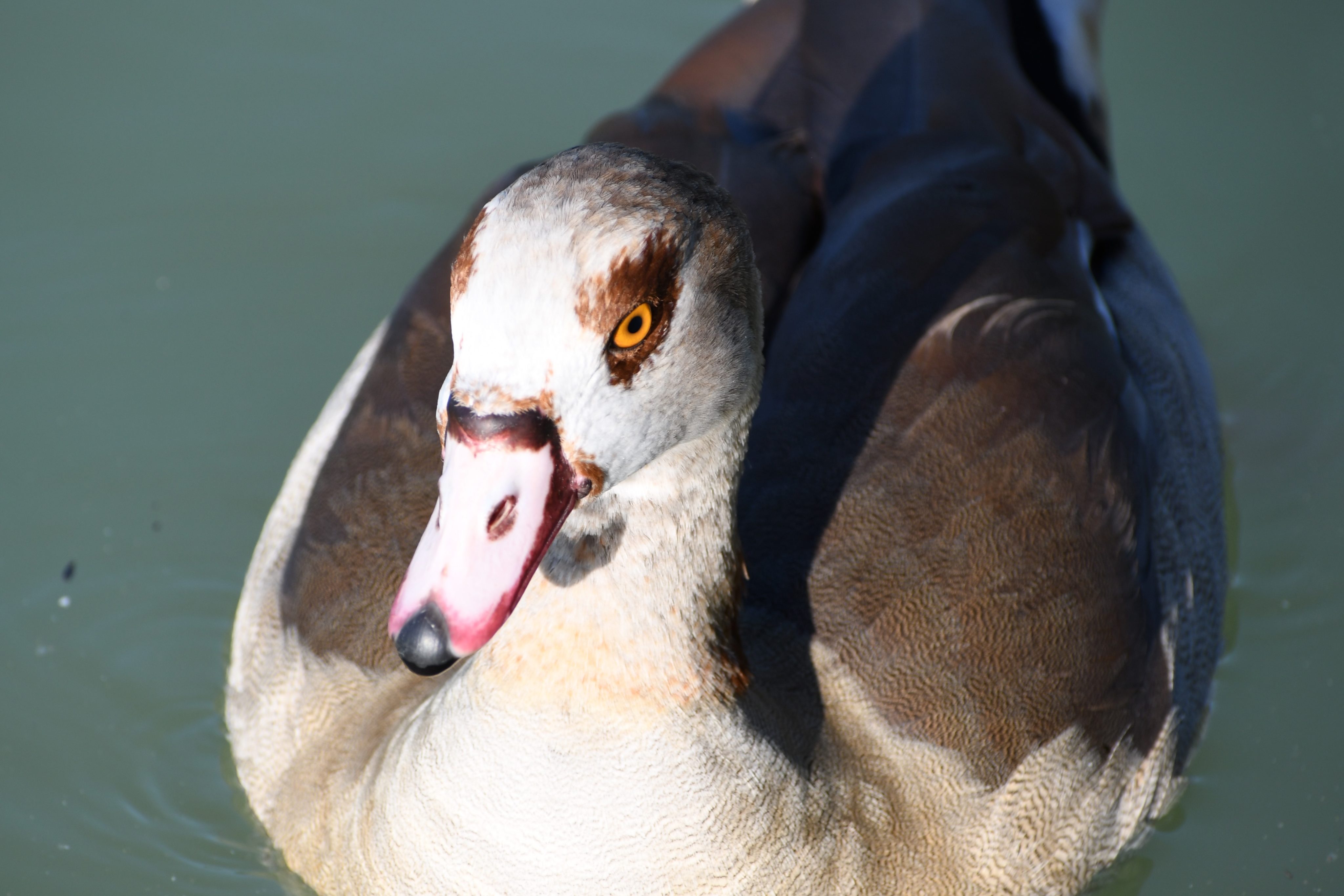
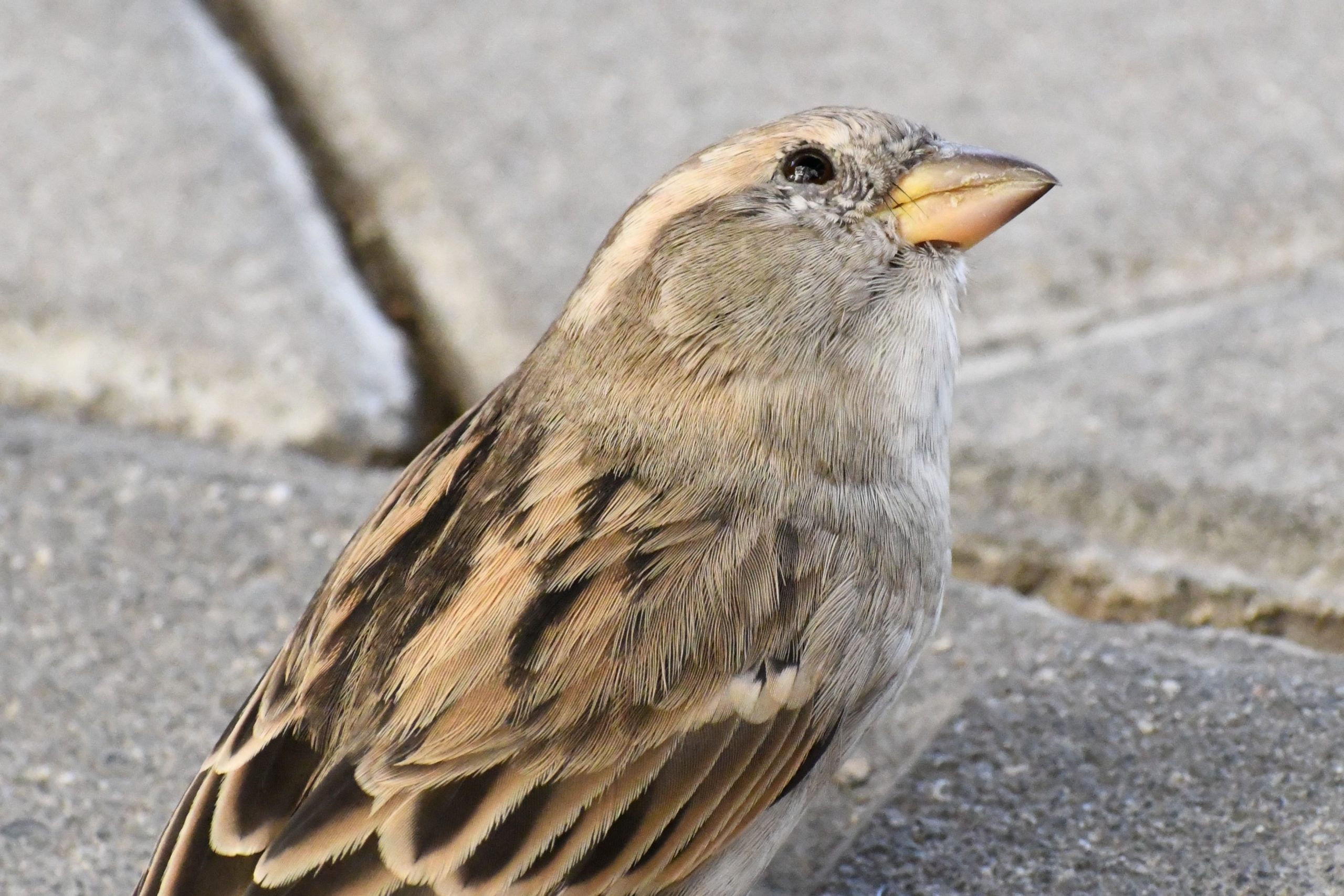

In Portugal, I aspired to do bird-watching at the “Parque Natural da Ria Formosa,” but it turns out birds get up early in the morning, unlike the rest of us. Only city birds like the Egyptian goose, parrots, Eurasian magpies, and sparrows keep to a more humane schedule. We settled on a four-hour afternoon cruise from the port at Olhão to the islands of Culatra and Armona. Cruise is a poor choice of words. It was more like a chug, listening to our guide attempt to shout information over the engine’s noise. In my mind, I saw him yelling at home as if it were an ordinary thing. I asked him if it bothered his wife. She screamed from the background, “I’M OKAY WITH IT.”
We stopped for a Super Bock and lunch at a patio restaurant in the quaint town of Culatra. Afterward, I made a mad dash across the island, half of the walk down a sidewalk gauntlet of pastel-colored, patioed houses and the other half on a boardwalk that cut across sandy berms to the ocean-facing side of the island. I only had time to dip a foot in the ocean before returning to catch the boat. We stopped for another half-hour at Amona to stroll through the town and back up the beach. I took a quick swim in the cold water against a receding tidal current that I could have used as a resistance swimming pool. In retrospect, I don’t know what gives it the classification Parque, but based on empirical evidence, I would say that it means underdeveloped, sandy islands. The only birds we saw were seagulls. The flamingos are dancing out there somewhere, but I booked us on the wrong tour.
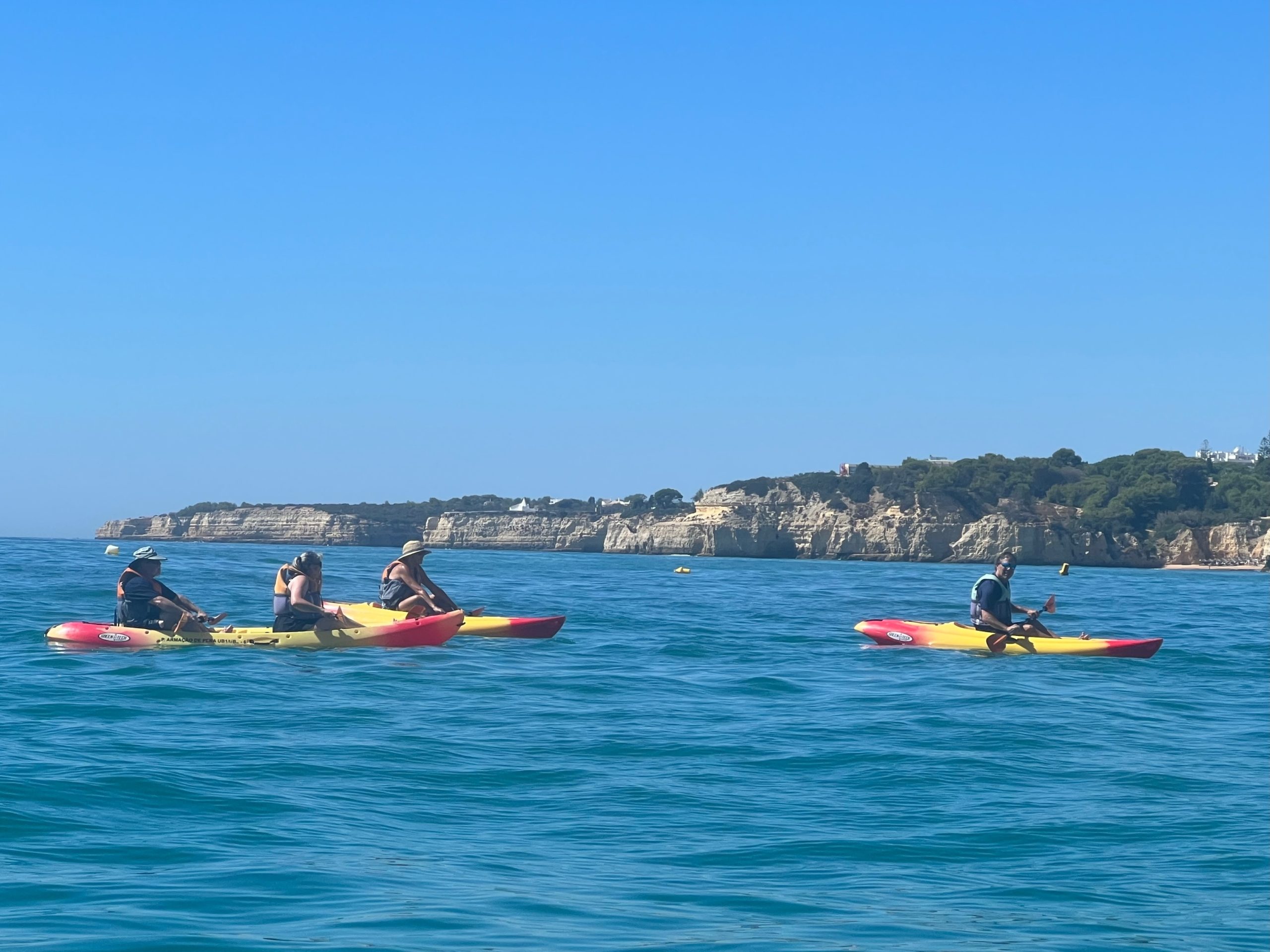
Our one-hour kayaking expedition didn’t quite live up to my expectations either. I envisioned working my way up the coast, photographing rugged rock formations and water entrances to caves. Instead, the outfit restricted movement to a narrow band in front of the town’s beach. The best excitement was watching my friend turn sideways in the wave and get dumped in the sand. Still, getting out on the water for sun and exercise is better than idling the day away.
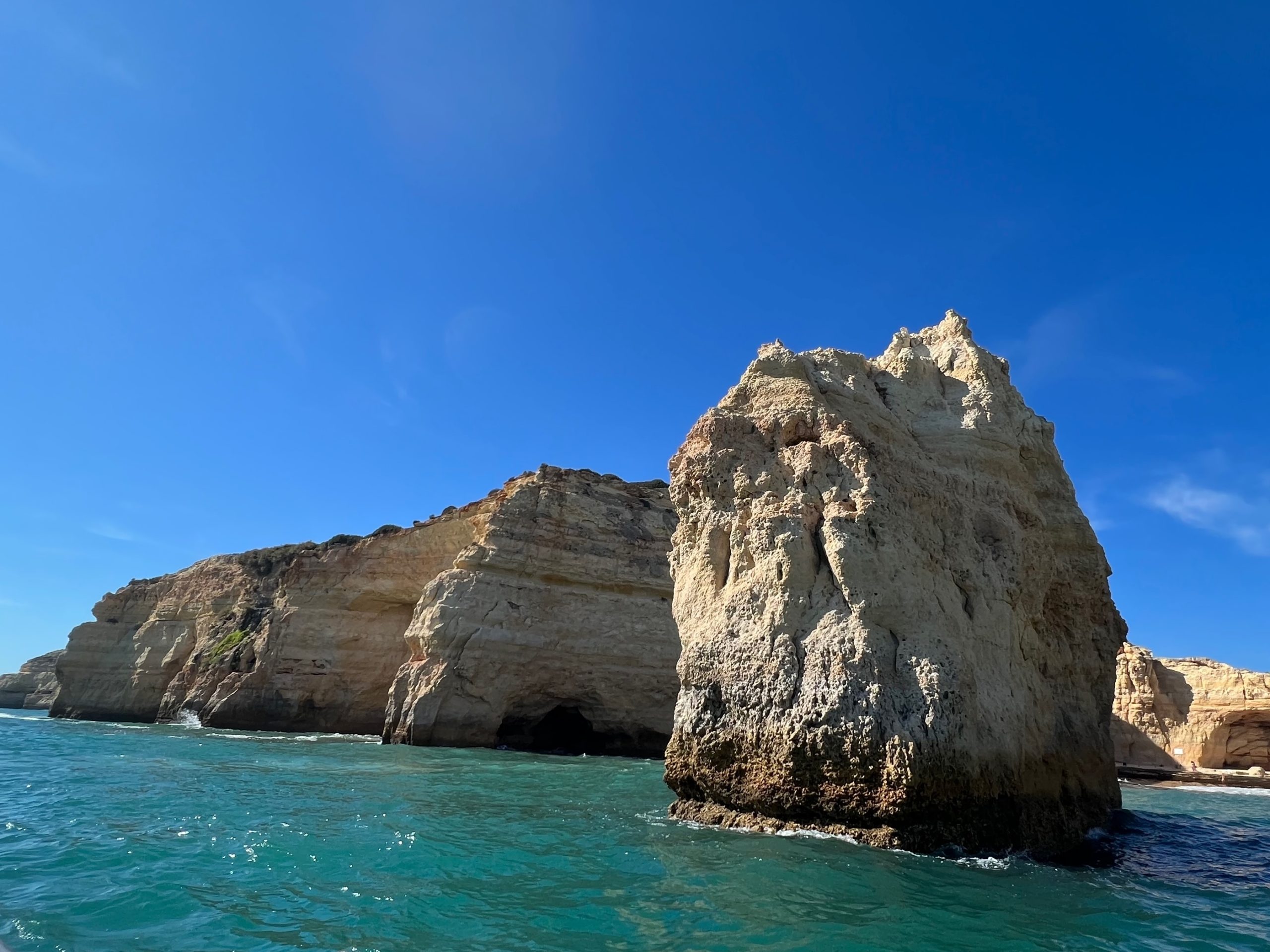
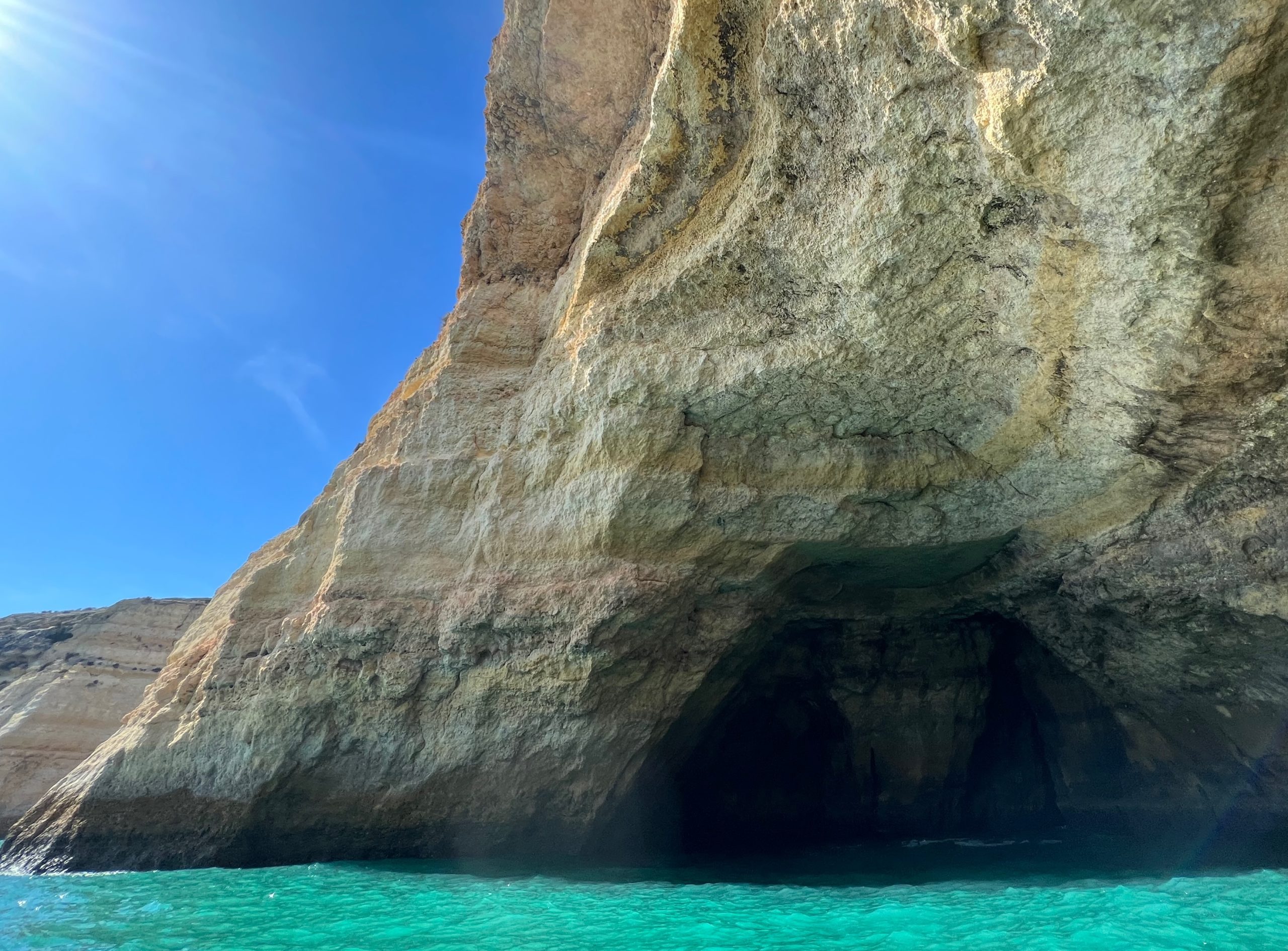
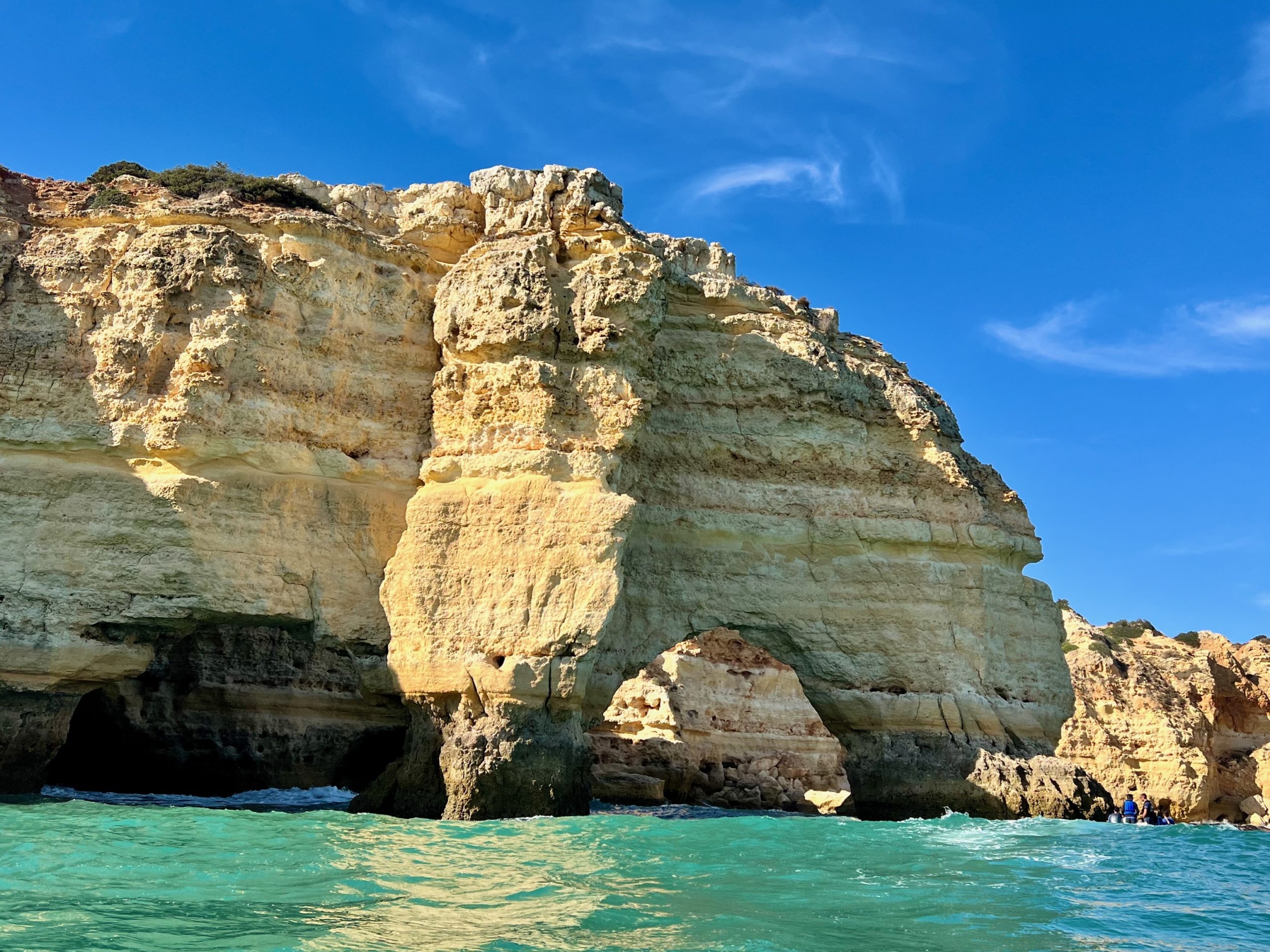
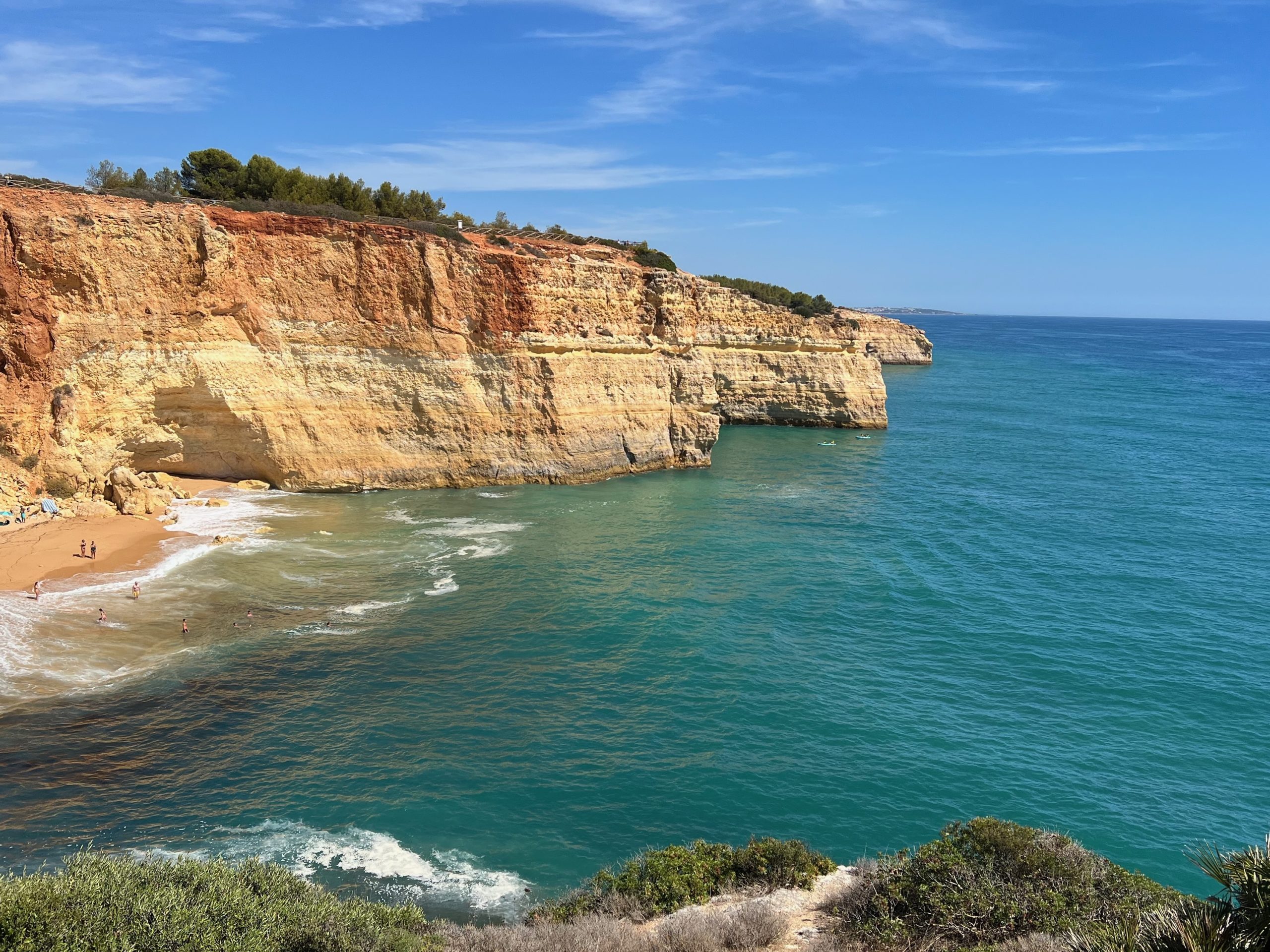
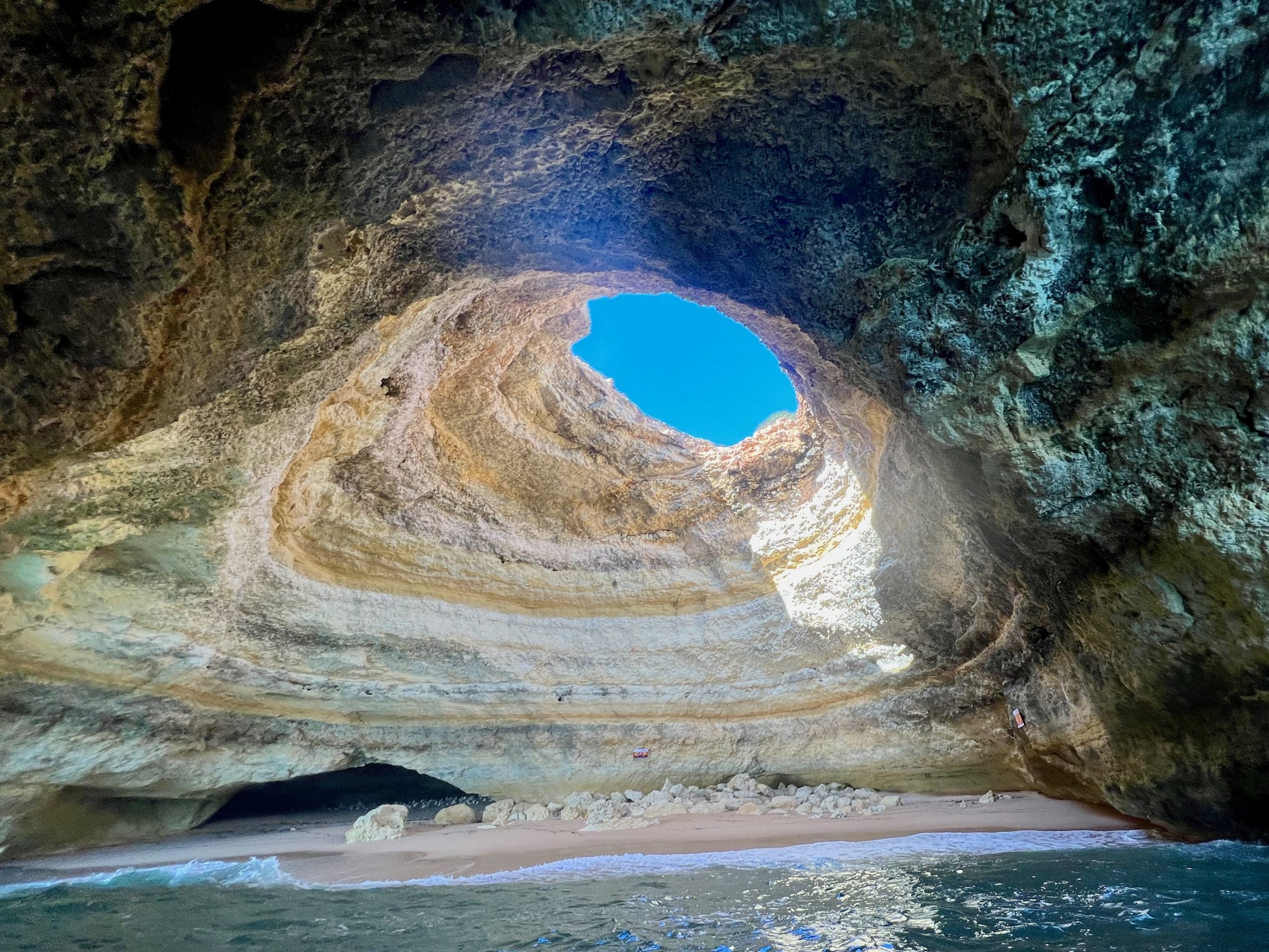
Despite the setbacks, the rugged coastline of the Algarve is very much within the scope of my “personal legend,” if I have such a thing, perhaps a pursuit of nature in the daytime rewarded with hanging out on balconies drinking socially at night. (I notice I don’t have too much problem with my anti-social drinking either.) The universe conspired in our favor with the boat ride adventure along the Benagil coastline, highlighted by the famous Bengali cave, a deep ocean swim, tunneling through a small water cave entrance smaller than the boat at the top of the swell, and capped off with a high-speed beaching of the ship.
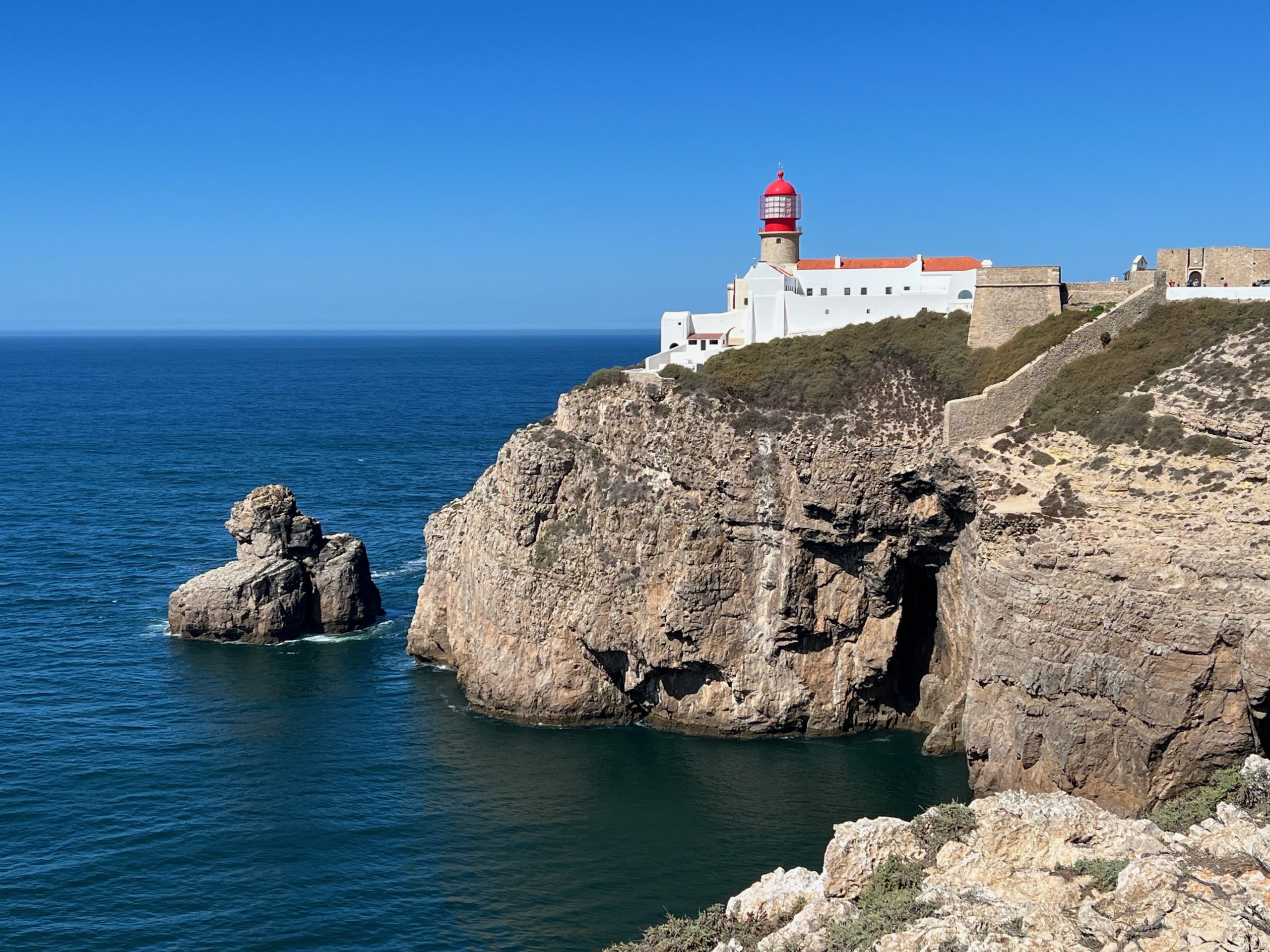
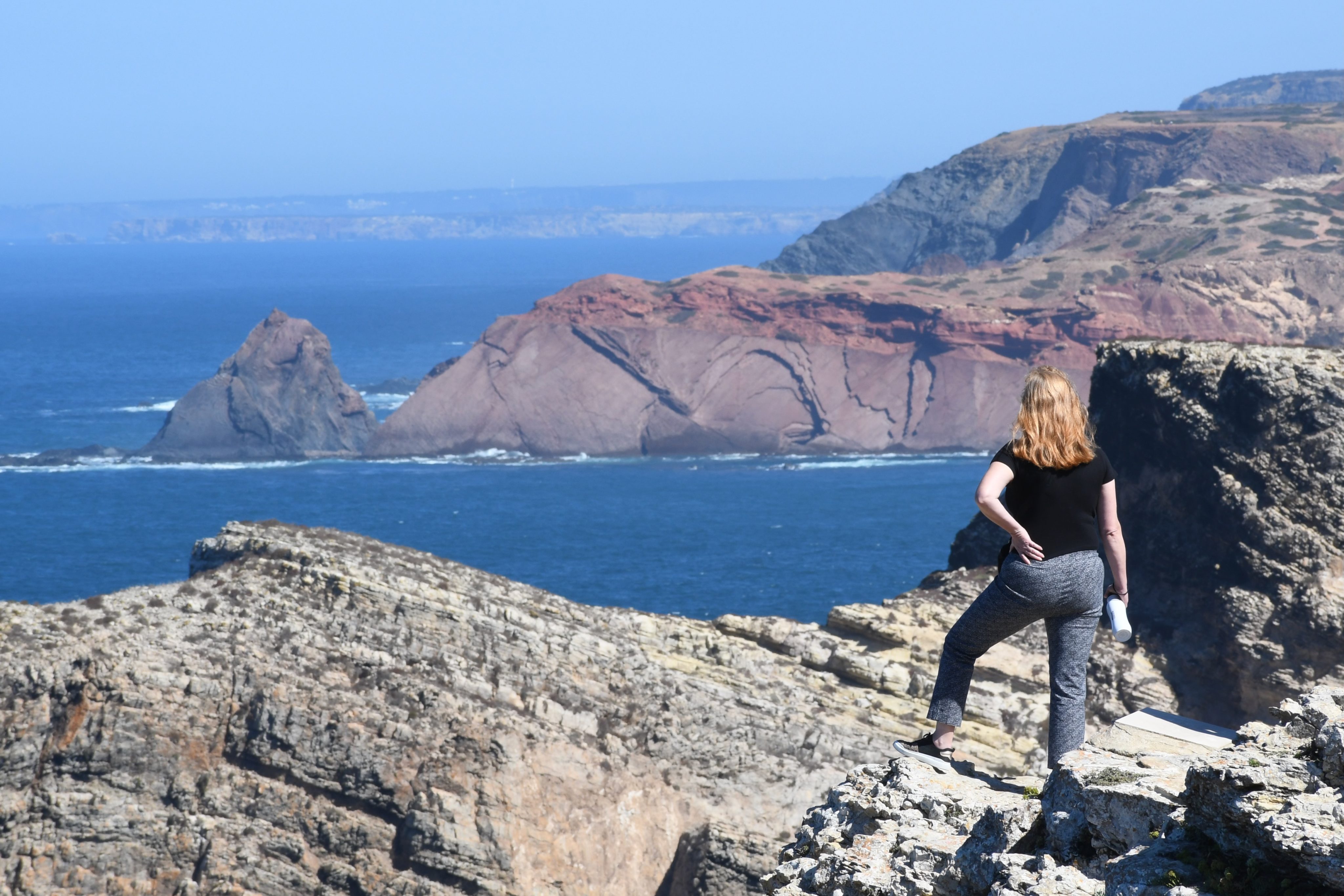
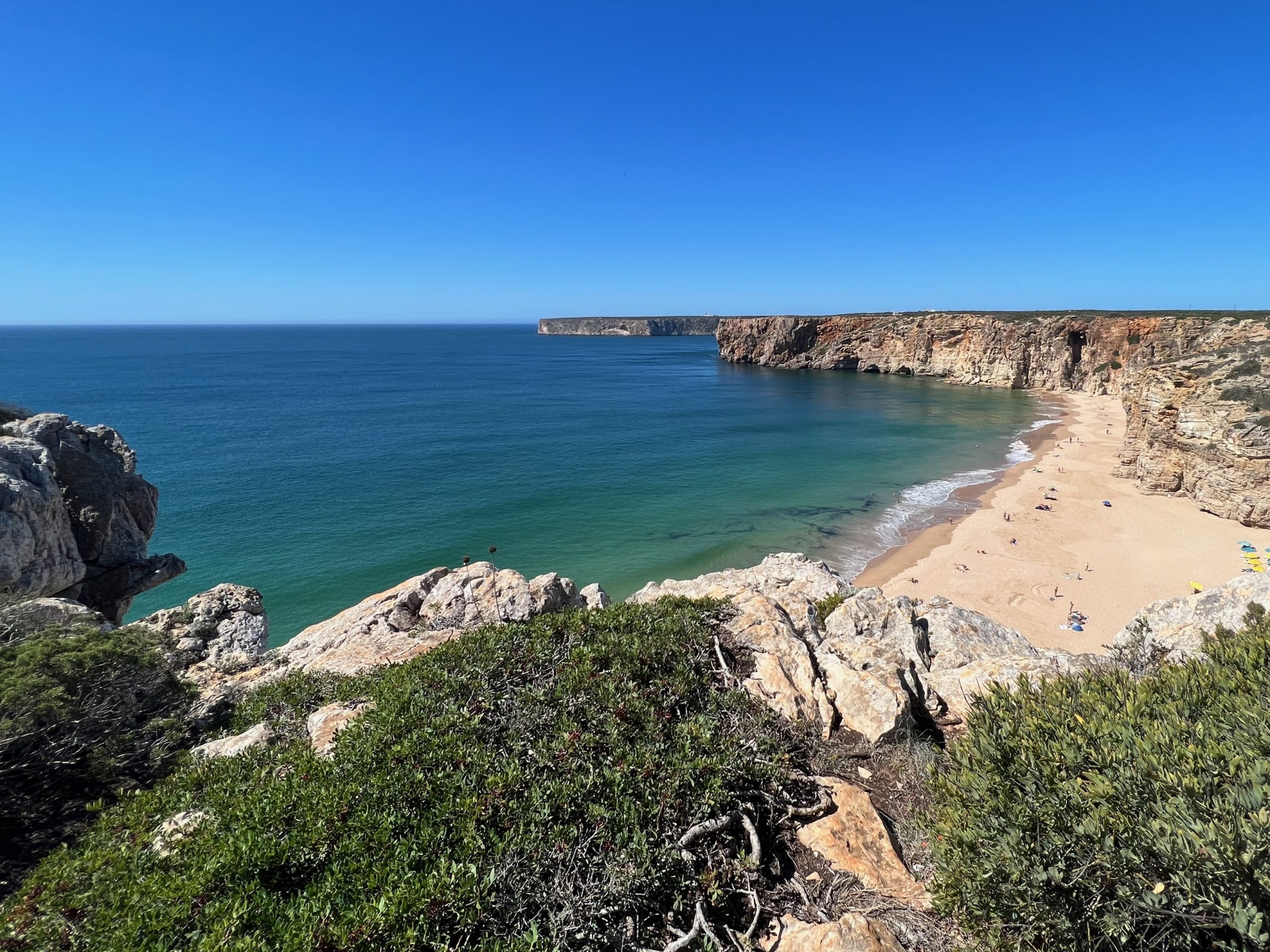
Another highlight was standing on Farol do Cabo de São Vicente, the end of the world, the furthest southwest point of Europe. The promontory reminds me of the Irish coastline (although I’ve only seen it in films), with sheer cliffs rising hundreds of feet from protesting waters that crash at its feet. Despite my best efforts at pictures, the landscape is too big. It is one of those spots you have to see for yourself. Another simple pleasure was seeing the ear-to-ear smiles and enthusiasm of a Japanese father and daughter pair conversing with GF in Japanese, offering to take a picture of them together against the dramatic backdrop of the sea cliffs, penetrating a language and personal barrier I couldn’t. Ironically, the connection suggests how isolated you can be in a foreign land.
The Fortaleza de Sagres is one of the many vantage points for the rugged coastline. The fort hides a significant hike and a great view back to the Cabo. Fishermen drop their lines from the top of the precipice into the Atlantic below, traversing more air than water. Prince Henry the Navigator built the fort in the 15th century to protect the town of Sagres from Barbary pirates, although I don’t see why those pirates wouldn’t just pay a few euros for a meal and Super Bock, like everyone else. The wine and beer were incredibly well-priced relative to any stateside restaurant or bar, typically coming in at under 15€ for a decent bottle and 5€ for a pint. I think I know where the pirates went. We took a picture of the facsimile of Prince Henry for GF’s mom, who trained with him back in the day (wink emoji here).
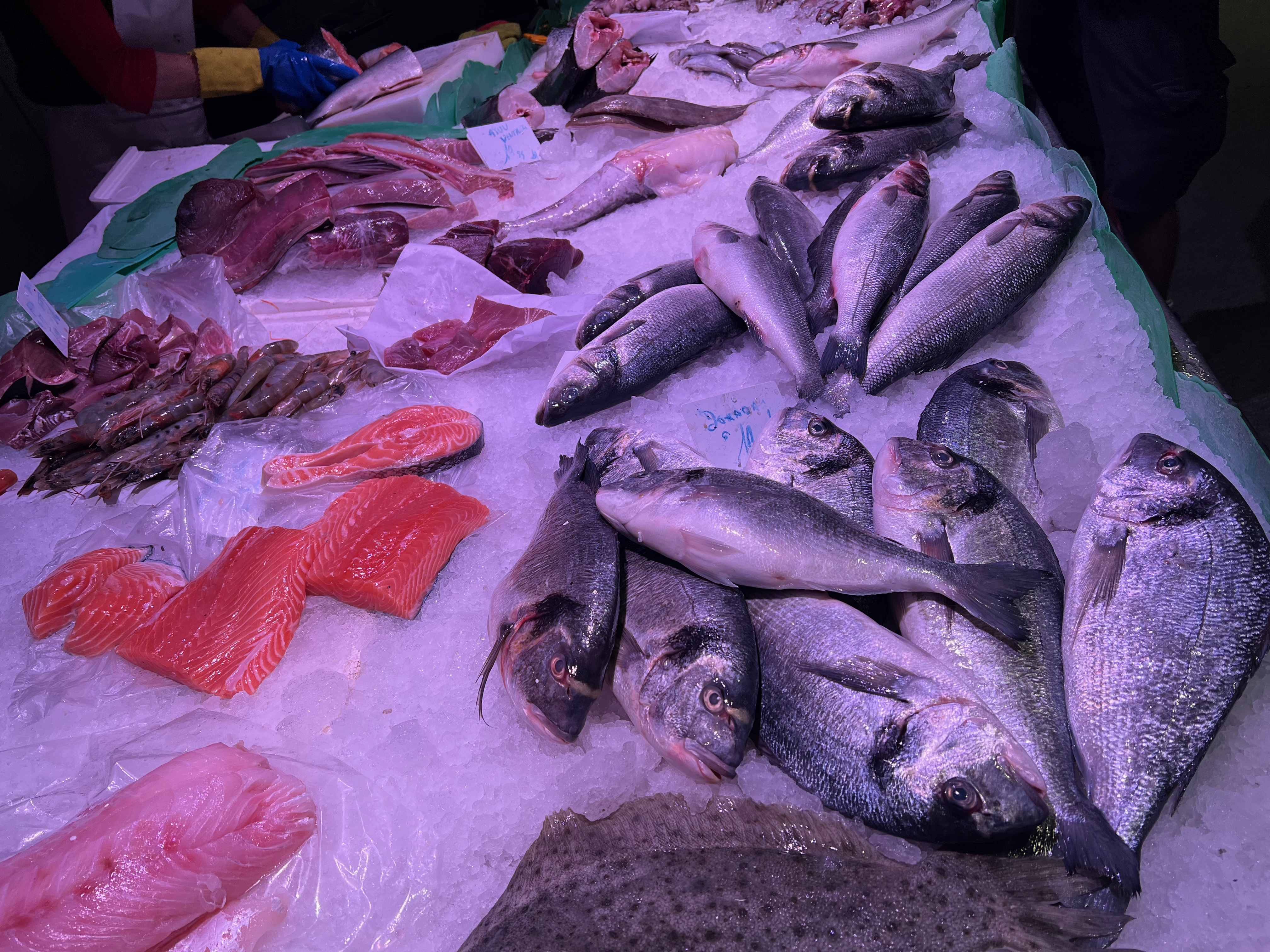
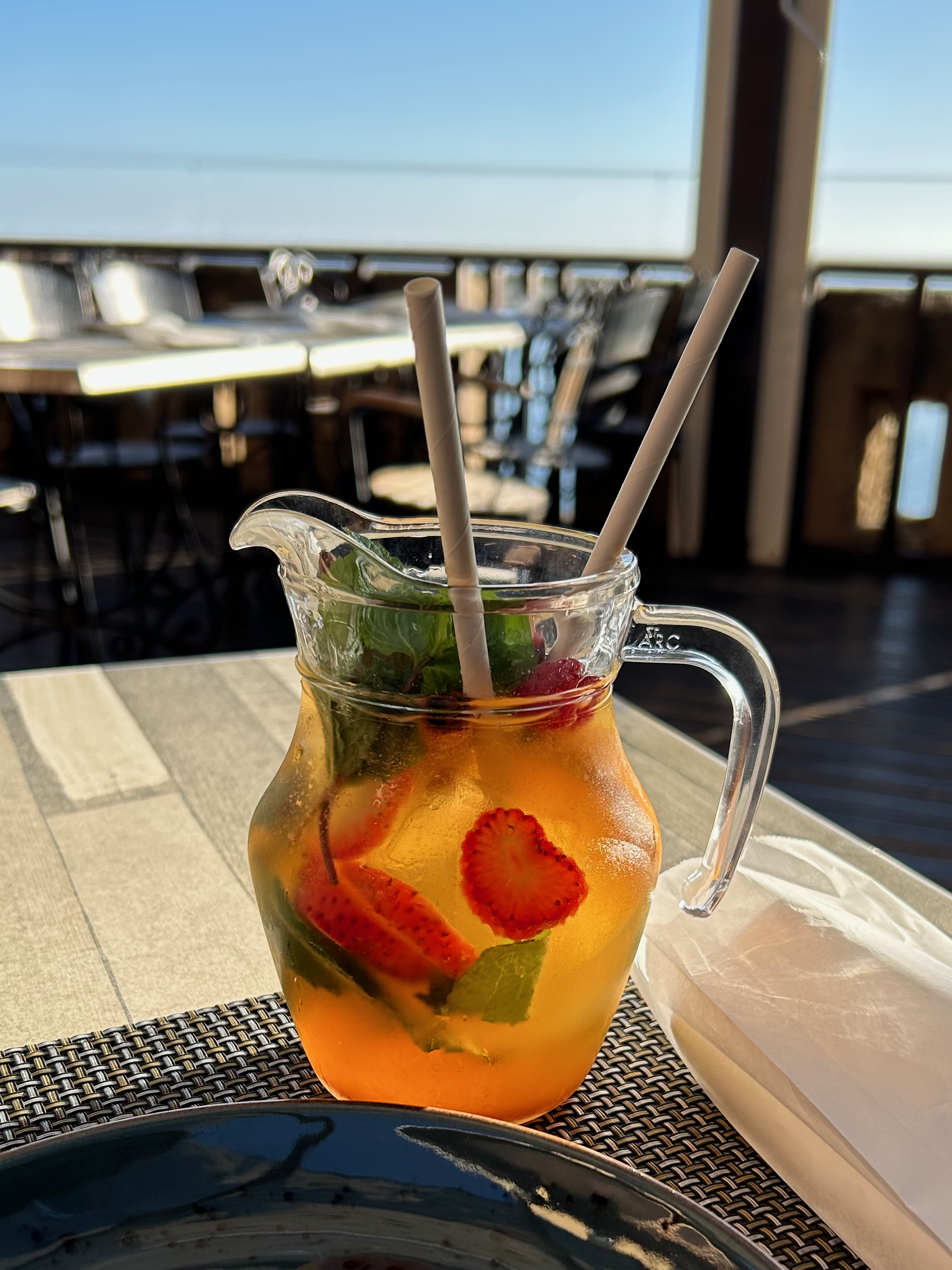
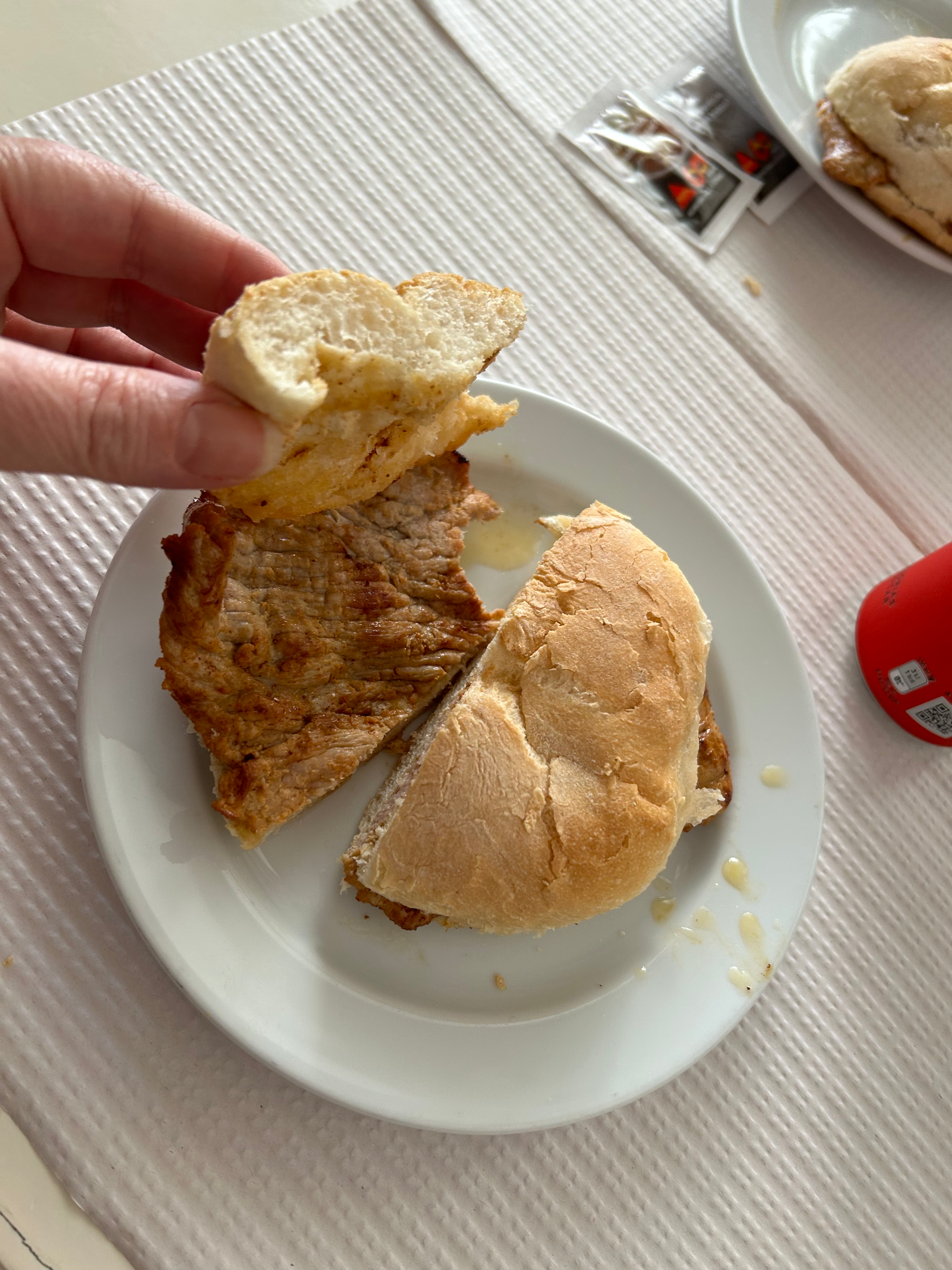
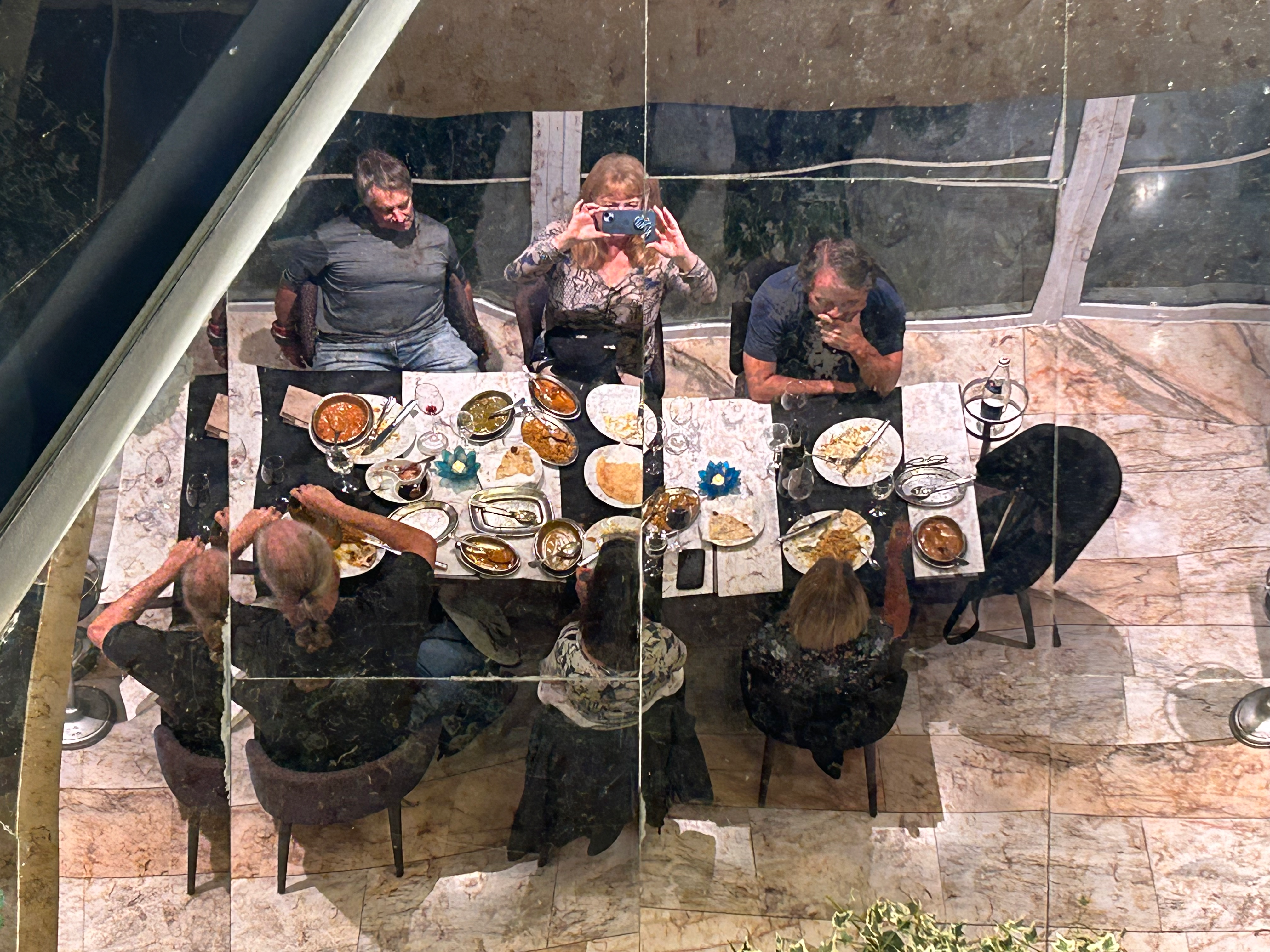
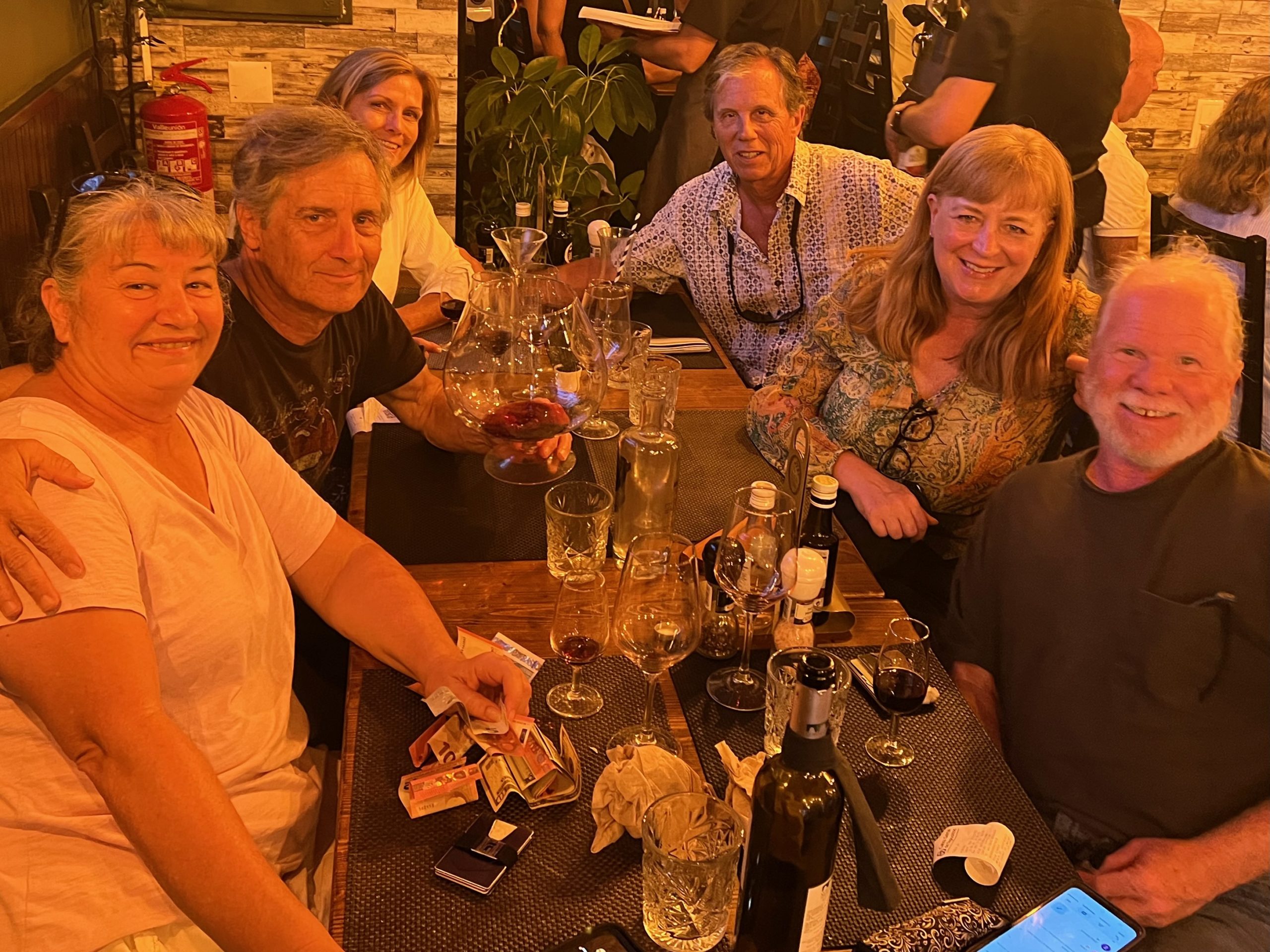
As much as I tried to minimize my food intake, trying not to come back five or ten pounds heavier, food was a big part of the trip. We found the most authentic meal in Grandola on the ride from Lisbon to the Algarve. The expressway sign suggested food at the Grandola exit. It turned out to be five miles off the highway. We found the Colher De Pau Café-Restaurante, a small, unpresumptuous restaurant that served the blue-jeaned, working men their late afternoon beers. I’m unsure if the restaurant was open, but the mother-daughter team served the one item from the one-item menu: a pork sandwich on plain white bread. It tasted like a tender piece of bacon.
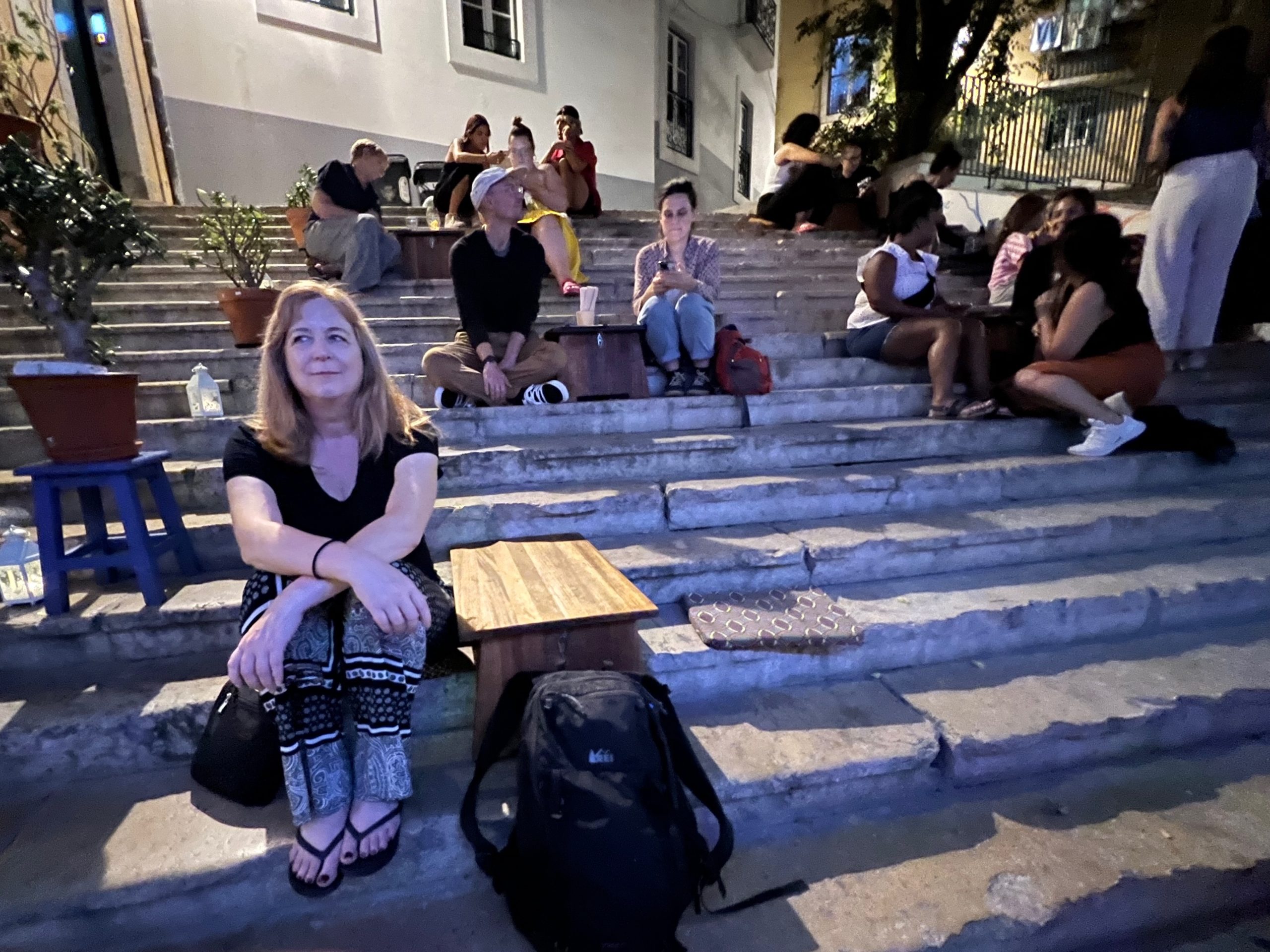
My favorite venue was the Food Temple in Lisbon. After having a panoramic view and a beer at Miradouro de Santa Luzia, we strolled down a dark, narrow alley into an otherwise non-descript cobblestone square with laundry hanging out a window, satellite dishes pointed to the sky, and entrances to modest apartments. However, the outdoor seating was on a stone stairway with tables strategically placed at different tiers. The wood-board tables were custom-fitted to the height of the stairs, with no legs on one end for the higher stair. We dined on olive appetizers and vegetarian entrees and split a bottle of red wine. I asked our waiter what the backstory of the Food Temple was. I tapped into an enthusiasm unparalleled at any restaurant I have ever visited. The other question I asked was how a vegan restaurant can serve butter, but it was some spice spread. The experience was augmented by the performance of the now classic sitar and synthesizer piece, “Take a Shower with a Friend. Save water,” by the immortal Project Mr. Bubble, our first minstrel of the trip. The lyrics and the title are the same. No offense to my good friends, but stinky and dehydrated would be better choices. I’m sure the feeling is mutual.
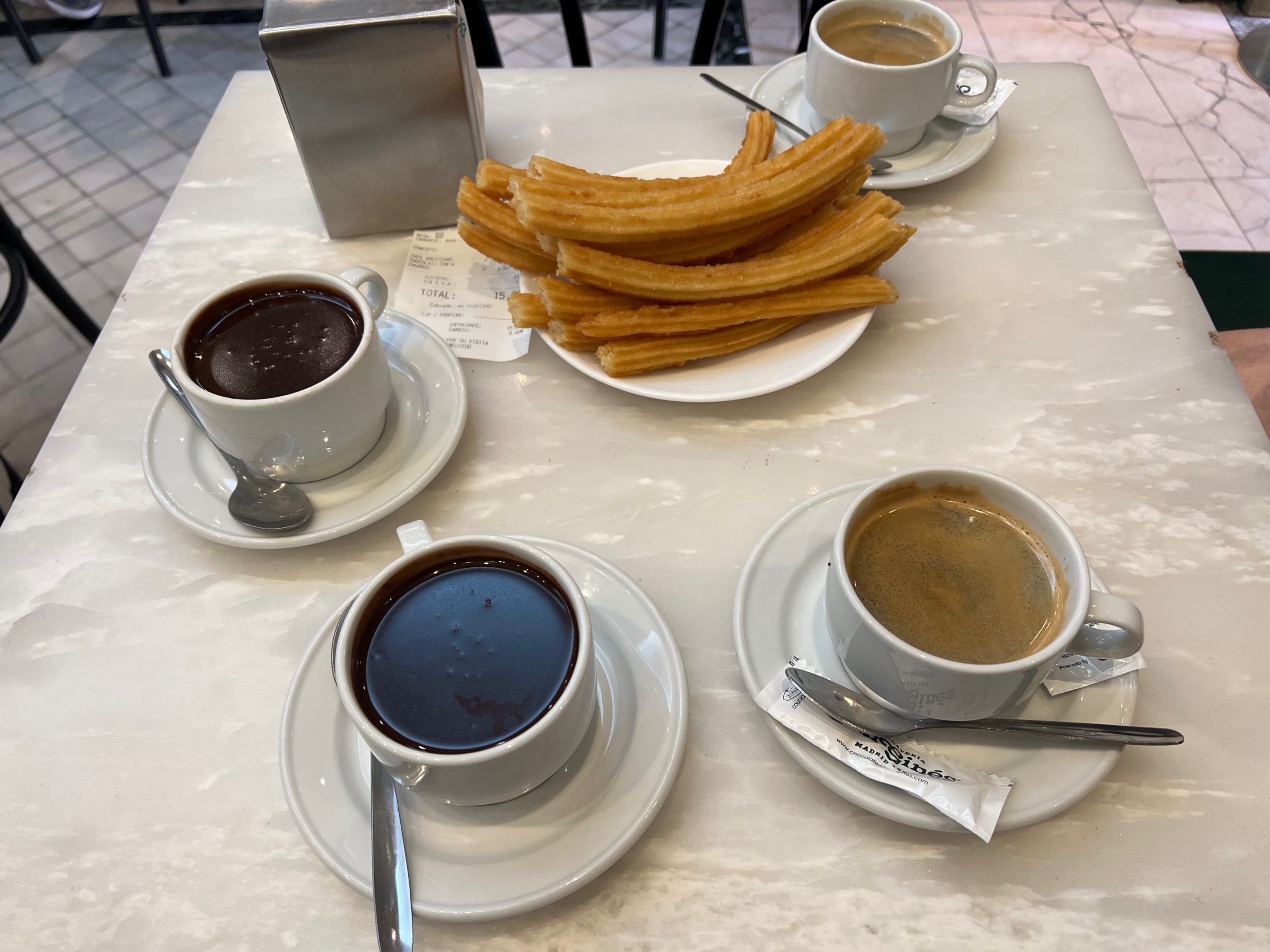
The cup of melted chocolate with churro dipping sticks at the Chocolatería San Ginés in Madrid was the most decadent meal, if it can be called a meal. It’s like squeezing the contents of one of those Hershey’s genuine chocolate-flavored syrup bottles into your mouth. I’m unsure if the genuine refers to the syrup or the chocolate flavor; Hershey’s sounds like cheese food to me. But I can’t be a denier, the real stuff was great.
We strolled the streets of Alfama in Lisbon, highlighted by the Elevador de Santa Justa and the views of and from the Castelo de Sao Jorge. We received some of the slowest customer service at one of the outdoor restaurants of the Miradouro de Sao Pedro de Alcantara. We speculated that our server went on break or the cook was busy raising the cow and growing the barley. The poor customer service is attributed to the lack of tipping. In South Korea, servers perform because that is what they are supposed to do. The tip is in the cost already. It sounds so civilized to me. I could easily live without tips. In Portugal, supposedly the servers don’t perform because they aren’t incented to. People warned us early on in the trip not to expect decent customer service. The difference between the two countries suggests that culture has something to do with it.
Not all service was poor, of course. I think of the little cafe across from our hotel in Barcelona where the cafe owner gave us a free croissant. GF conversed with him in French, speaking in another foreign tongue, like some James Bond character who speaks any language in any country. The owner suggested ideas for our stay in Madrid, at least that is what James Bond told me. I was pranked twice by a waiter at Tasca 26 in Porches, Portugal. Since I ordered the wine, I sampled the initial pour, swirling for viscosity, sniffing, and tasting as if I knew what I was doing. After I approved, he filled up everyone’s glass but mine and walked away with the bottle, over my immediate protests. Of course it was a joke. Then after dinner, I turned down the offer of a desert port wine, only to get my sampler in a glass the size of a gold fish bowl. It was all in good fun and taken that way.
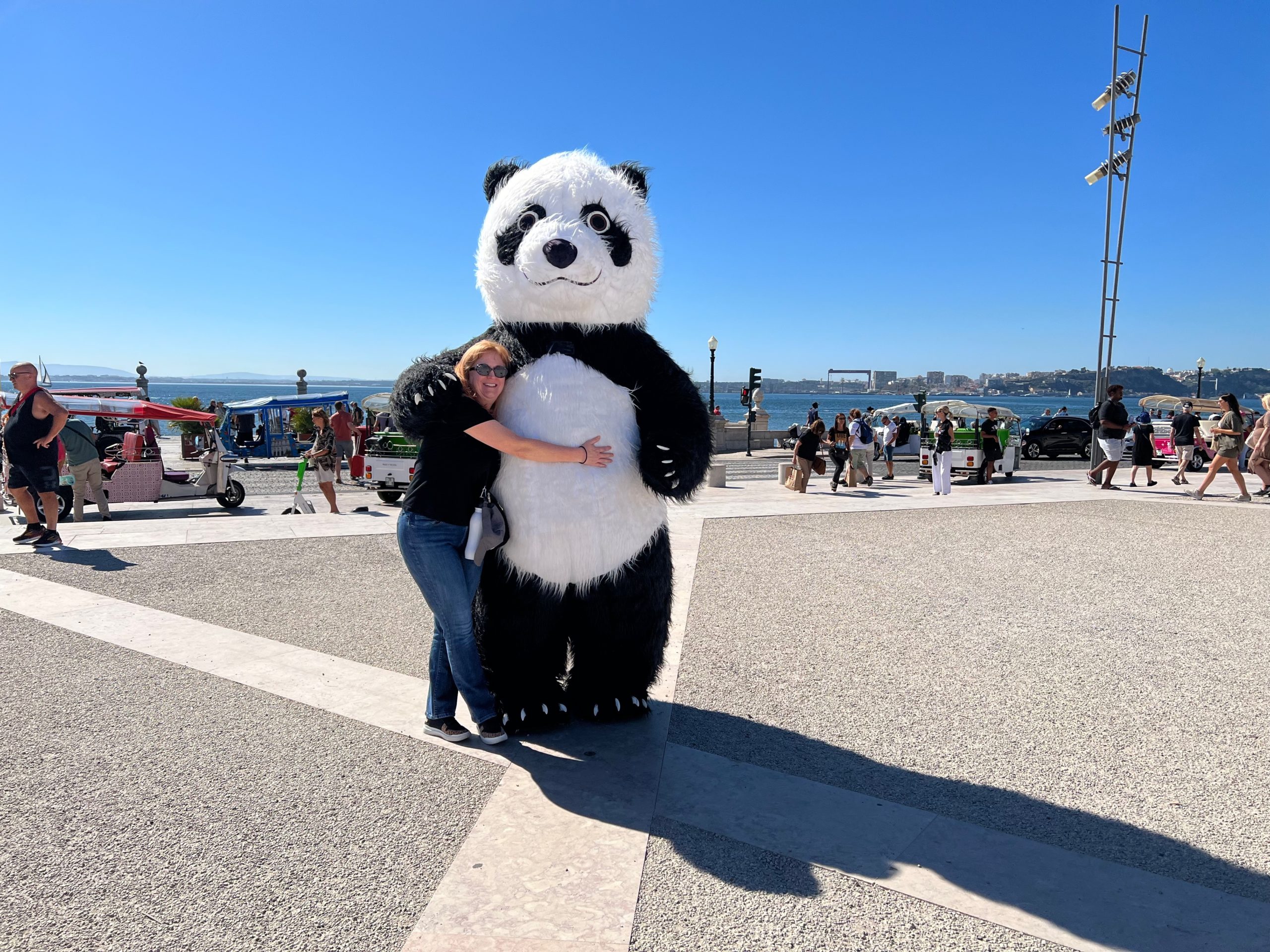
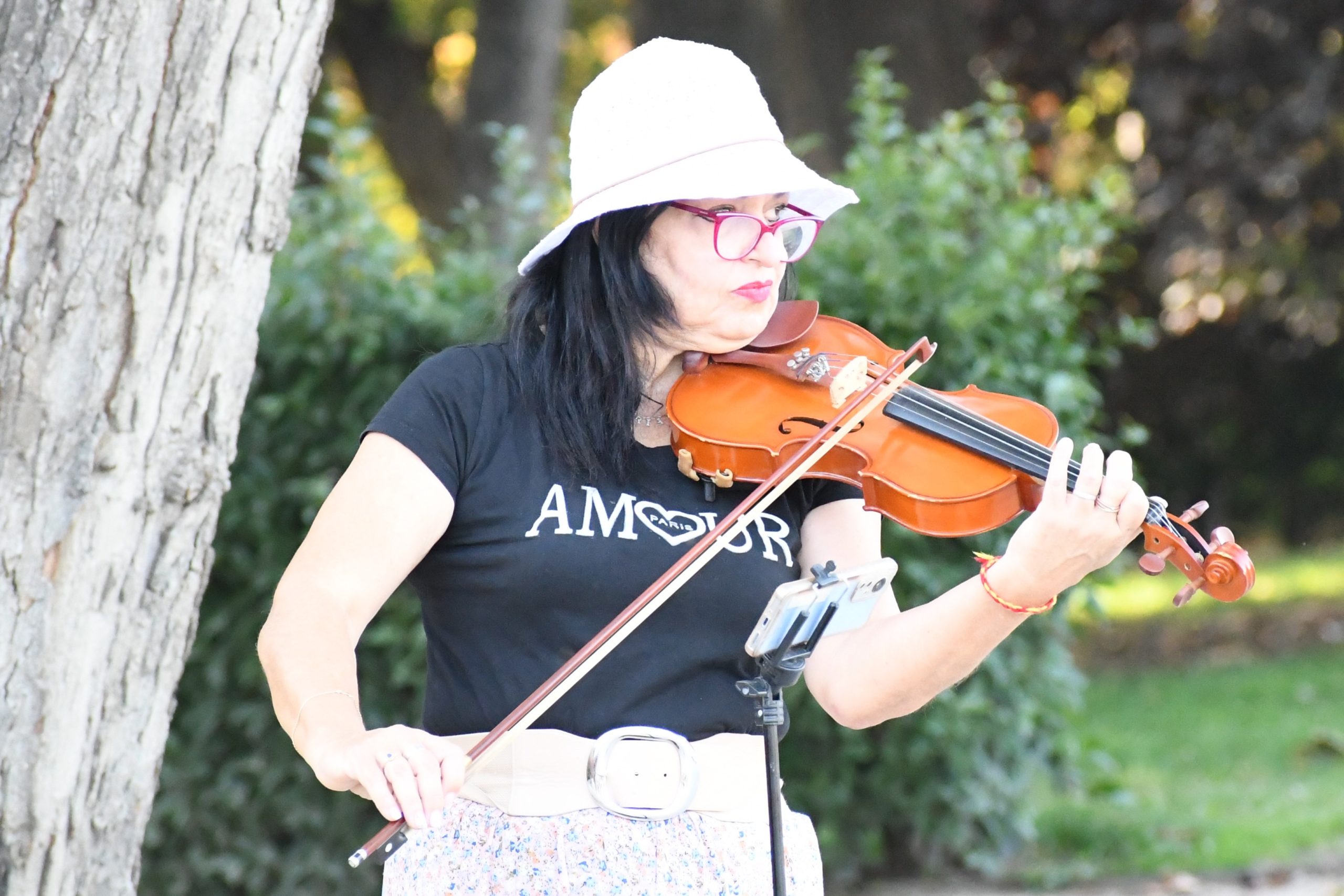
Some people work for tips or their equivalent. Plenty of decent street musicians perform with their instrument cases open for contributions, including guitarists, violinists, and even celloists. I hope they play for the sheer joy of it, using the tips only to measure their ability. In the Praca do Comercio, we encountered a furry Panda posing with tourists for tips. Straight begging might be better than standing on your feet for hours in the heat in a heavy Panda suit. We later met these critters in the other big cities. I don’t know what Panda says about Lisbon or any other place, but there is a fatal attraction to these photogenic fellows. We speculated that stealing a photo with one of these guys might result in subsequent Panda attacks. Why take a chance? What if they are all interconnected and looking out for one another? After all, it is a networked world, even for Pandas.
Street peddling seems like a hell of a way to make a living, like the small army of Black salesmen ( a description, not a judgment) who unbundle their parachute full of purses and shoes and anything else light enough to carry into squares and plazas of Madrid. I saw them starting with packed parachutes at noon and still selling at ten at night.
The big cities are not without their homeless and deformities:
- A man on his knees face to the ground with his cup in supplicant position.
- A man supine on a busy sidewalk by the train station with no shoes, feet cacked in black dirt, and disgusting toenails.
- A gypsy woman working her way up the street with a paper cup asking for money.
- Hambre signs on cardboard.
- Deformities too gruesome to describe.
And so on. The west coast of America is no stranger to these sights.
So does my head fill in intentional voids, a kind of existential “omwurm”? In real-time and in the absence of the pursuit of a personal legend, my head fills with all the worst-case scenarios. I try to turn those into humor by finding the most absurd worst case. Bad customer service turns into cooks running out to grow the vegetables and raise the animals. Intimidation at a car rental agency turns into a person hiding in the trunk with a hammer. The misery of working for meager tips in a Panda suit turns into a Panda pursuit. The yelling over a boat motor turns into a scene from the loud family. And so on.
My head should fill itself with gratitude. According to an article, only 5% of the world’s population has been on a plane. I empathetically took two trips via books and took one via jet. I lived the pursuit of a dream of a boy traveling across the Sahara desert and a woman suffering through a half-hearted marriage and the collateral damage of the Spanish Civil War. I saw natural wonders and explored historical yet vibrant cities, putting in over a five-mile-a-day average through trails on the Benagil coast, the cobblestone streets of Barcelona, the historical sites of Lisbon, and the busy streets of Madrid.
I had great times traveling with my girlfriend, socializing with friends on the balcony overlooking the Atlantic, and with surrogate family in the restaurants of Barcelona and Madrid. I sat at countless outdoor restaurants, sharing stories, food, and wine with my companions and crumbs with the sparrows and pigeons. I connected with our Catalan friend, impressed that I read a book about her culture. I had so many tapas they blur into one giant continuous meal, and I could drown in the vat of wine I drank.
A good metaphor for the trip would be the brilliant fireworks display exploding over the sea cliffs of the Portuguese Atlantic, an unexpected and welcome surprise. Gratitude is something that comes after the fact. Hopefully, this piece fills that void.
